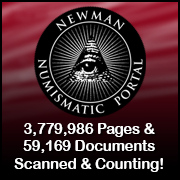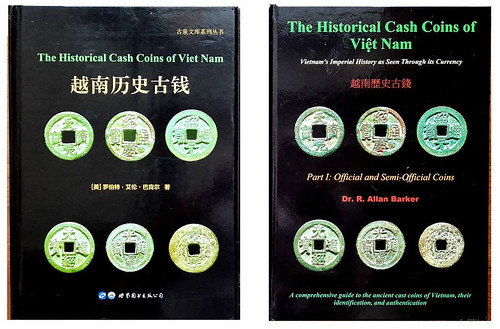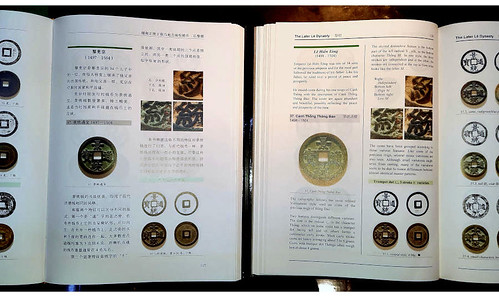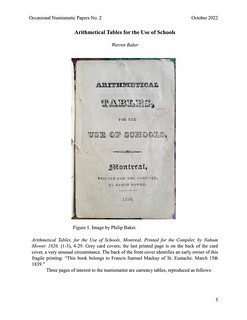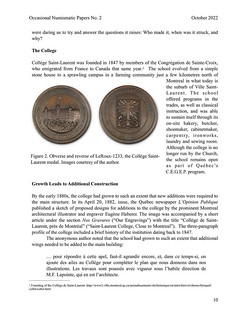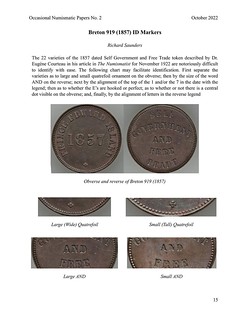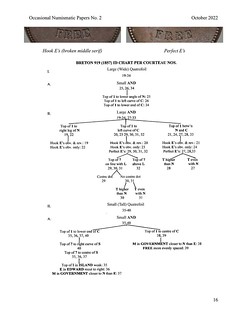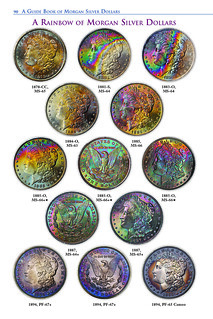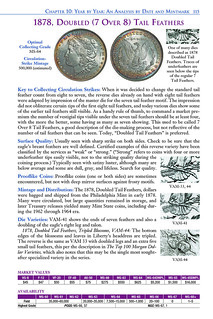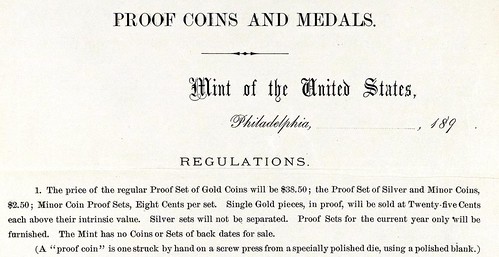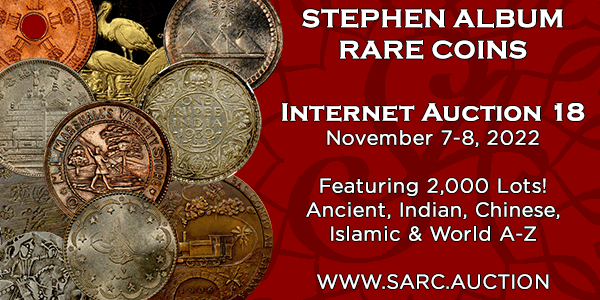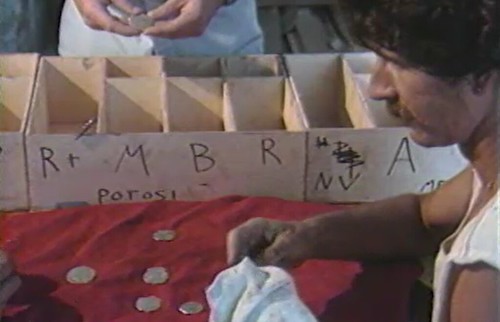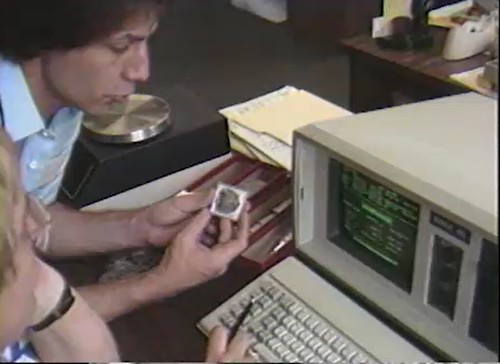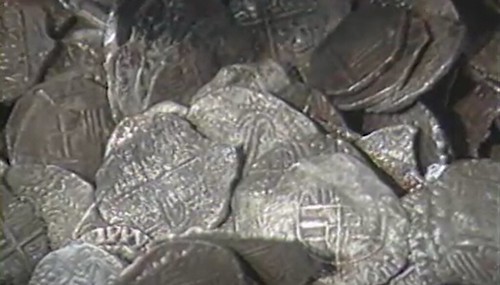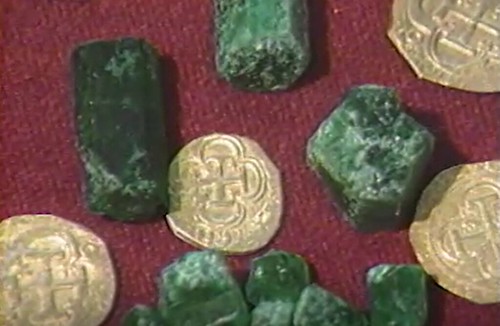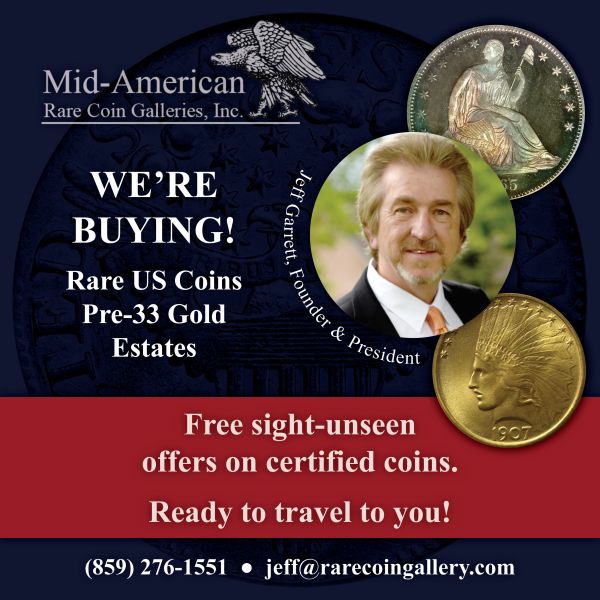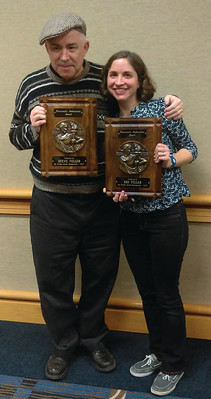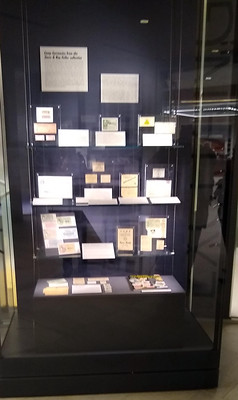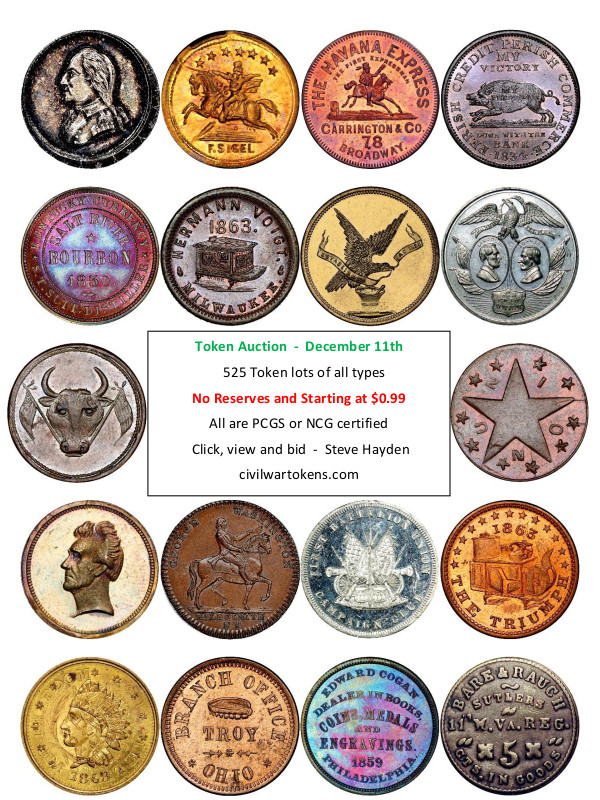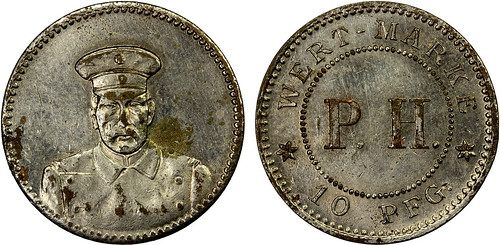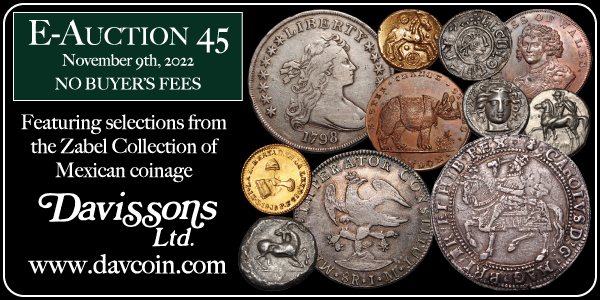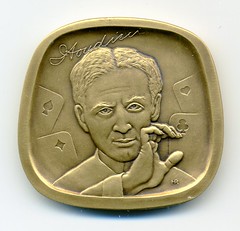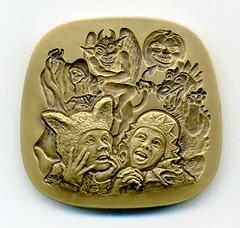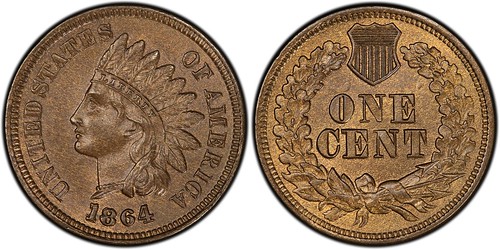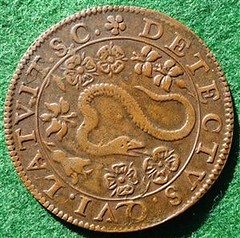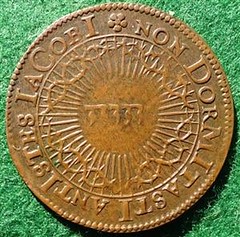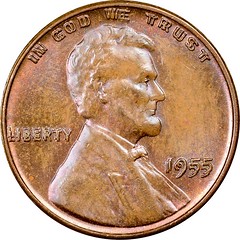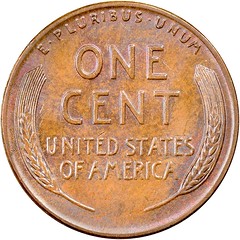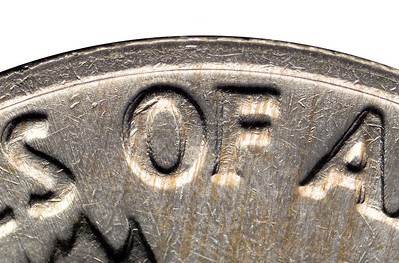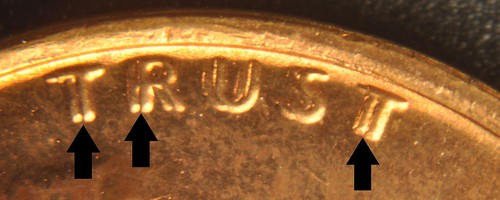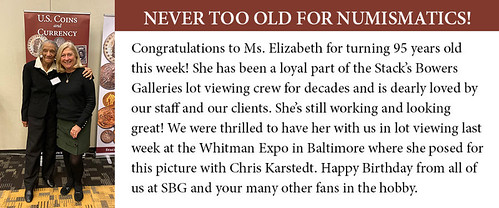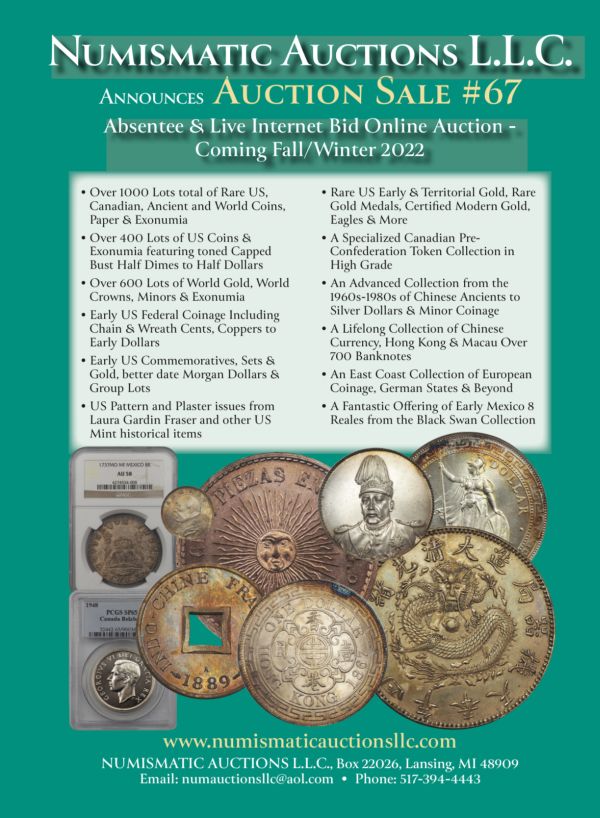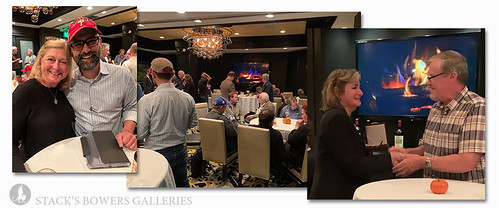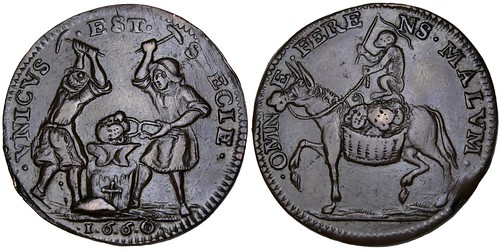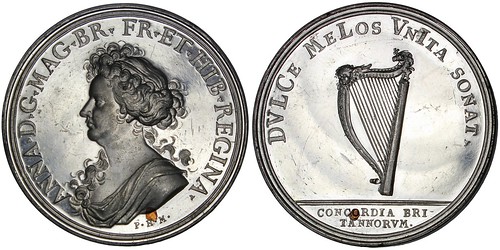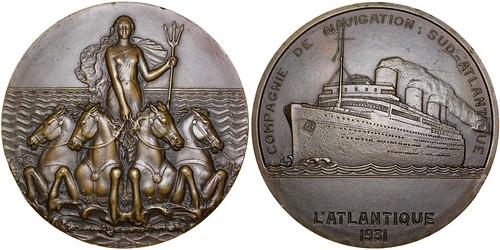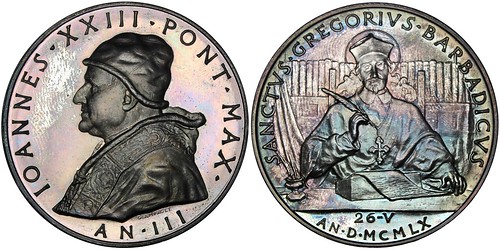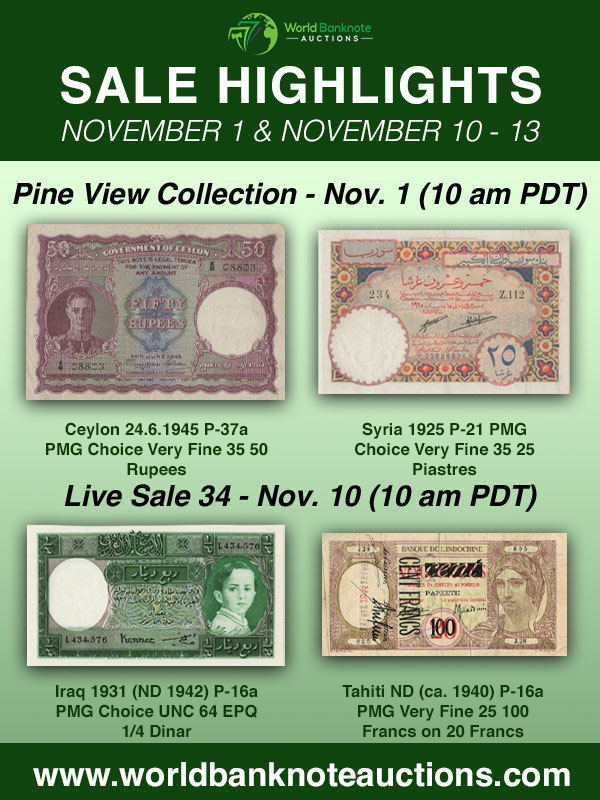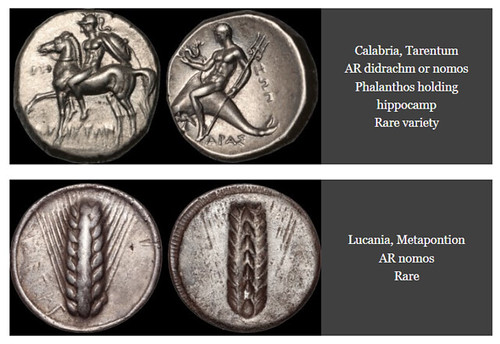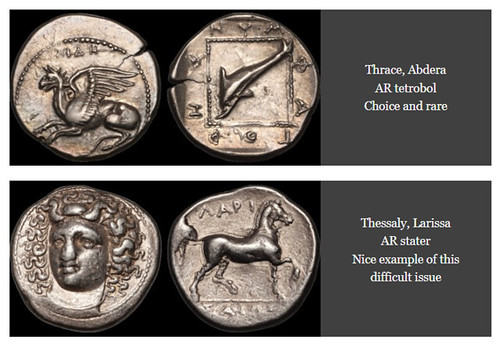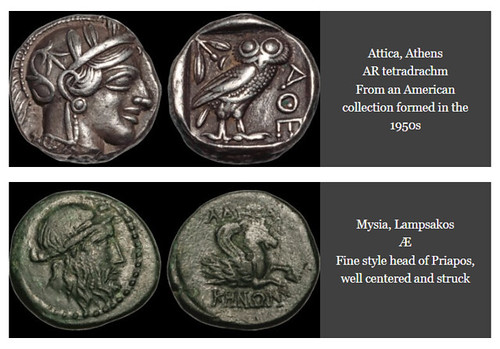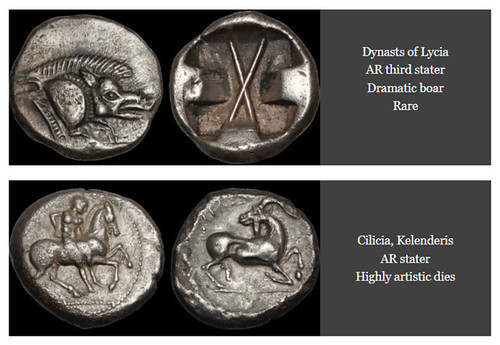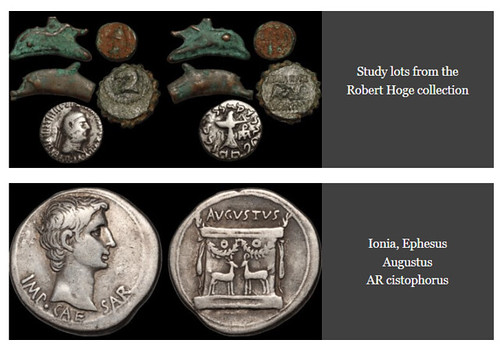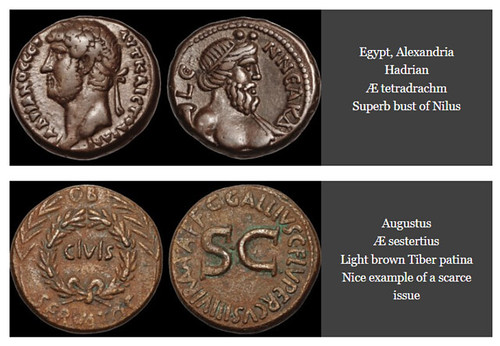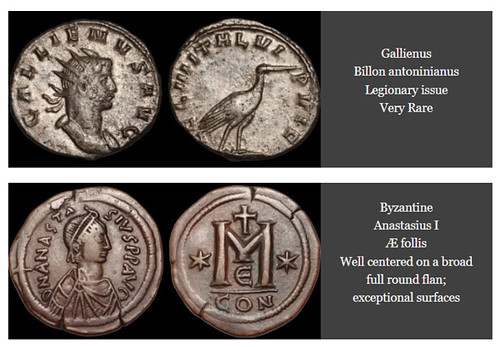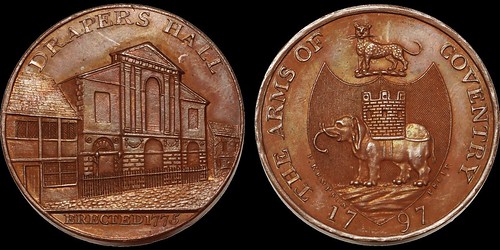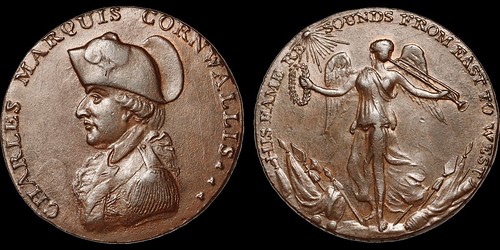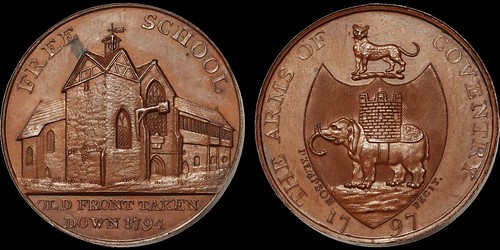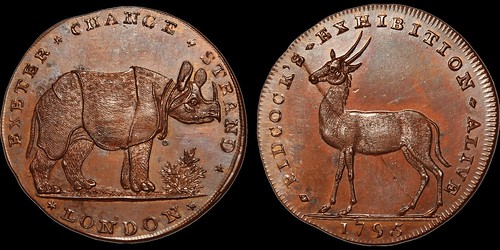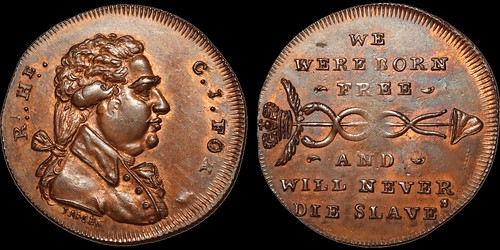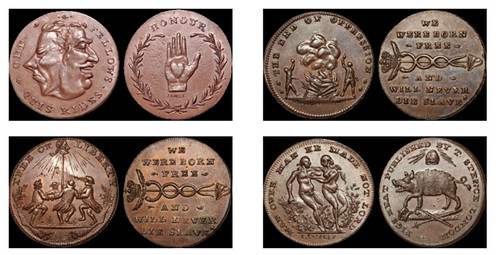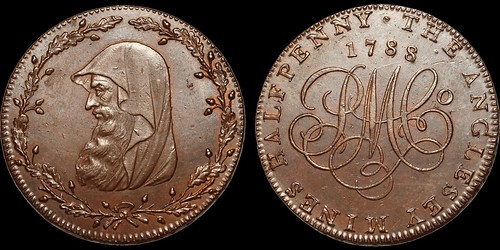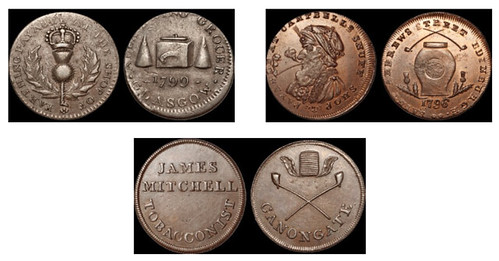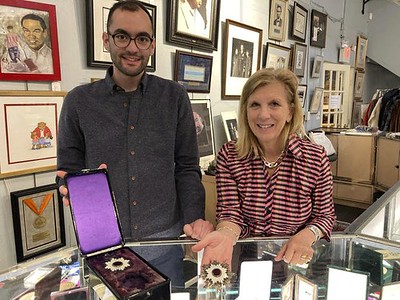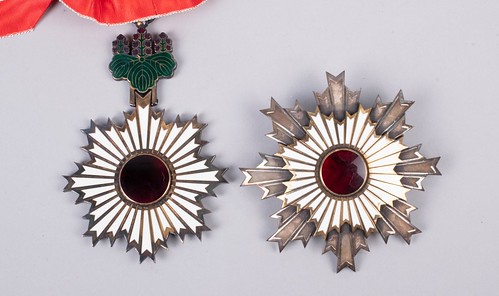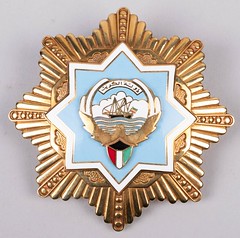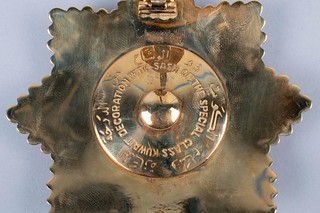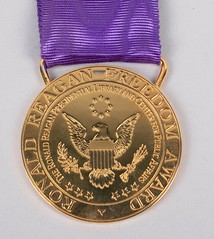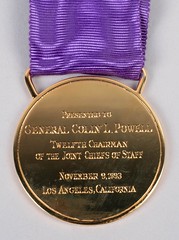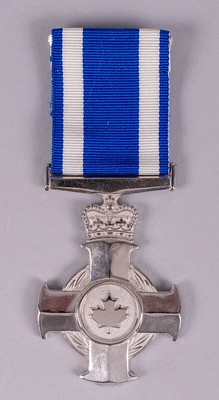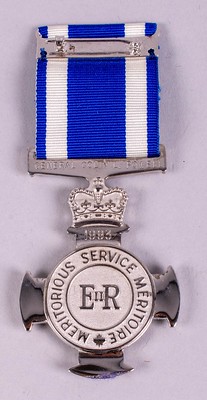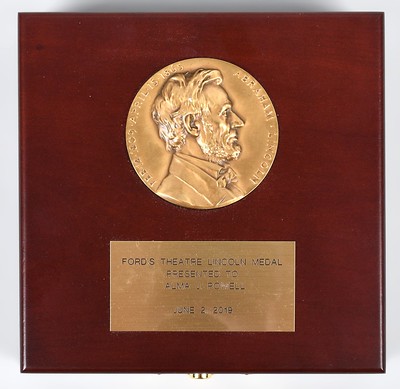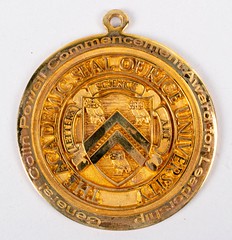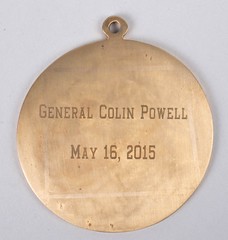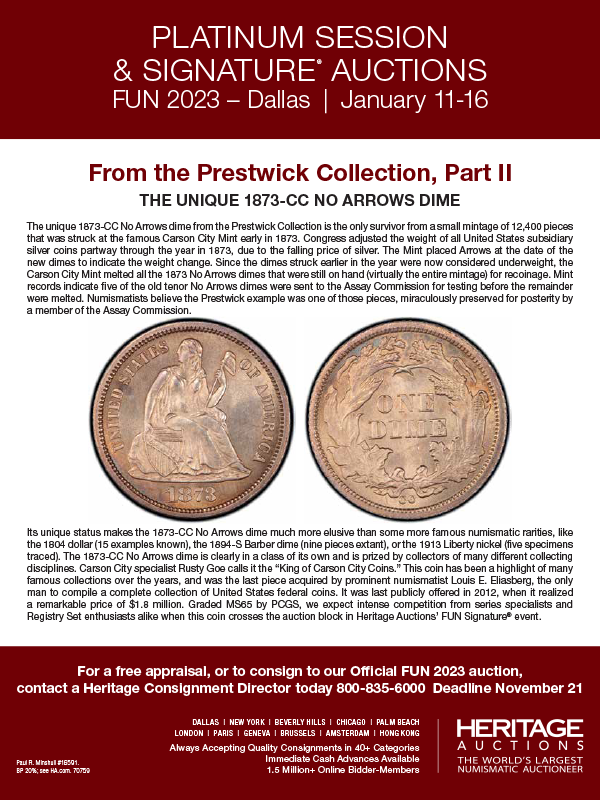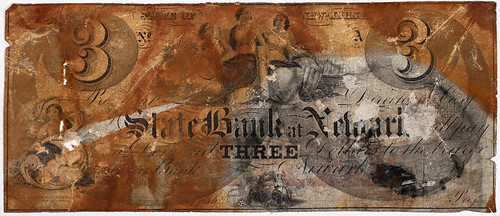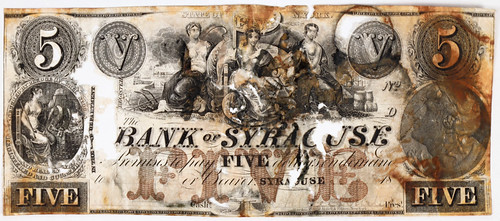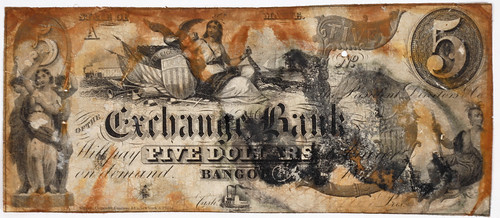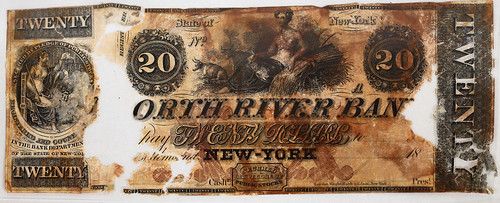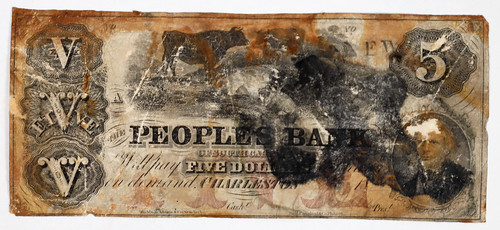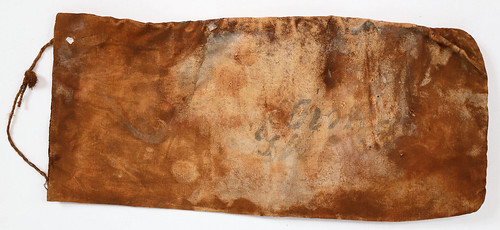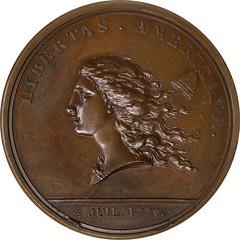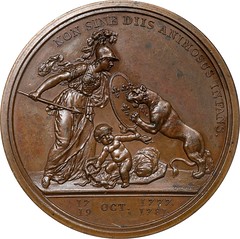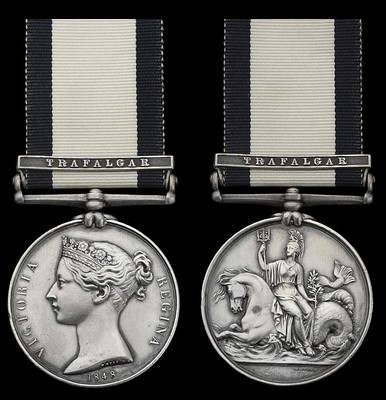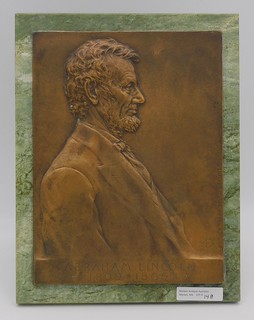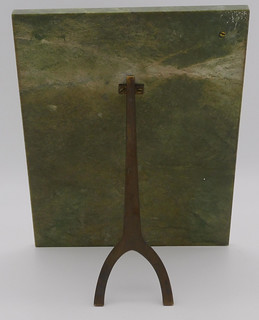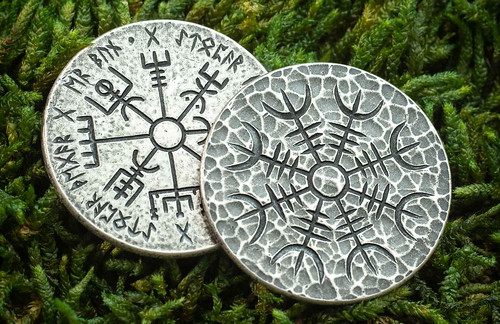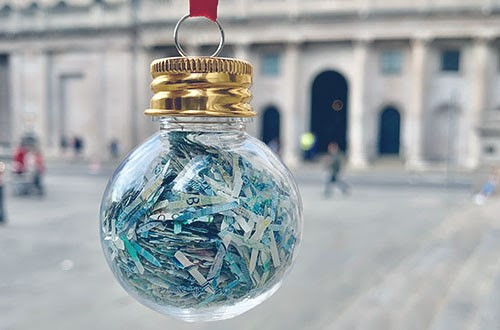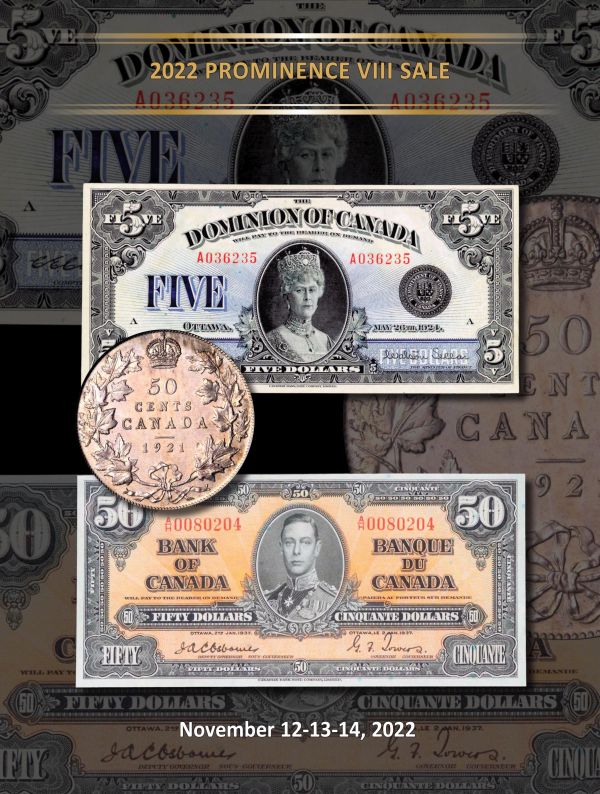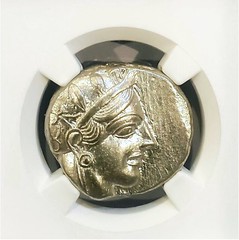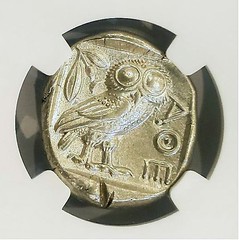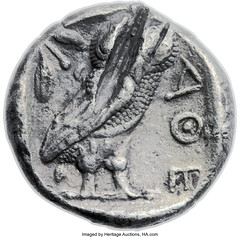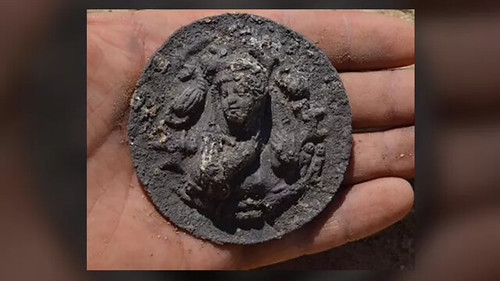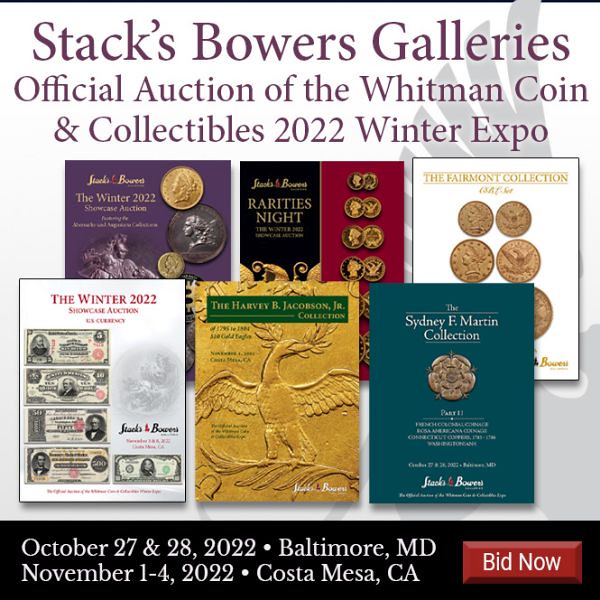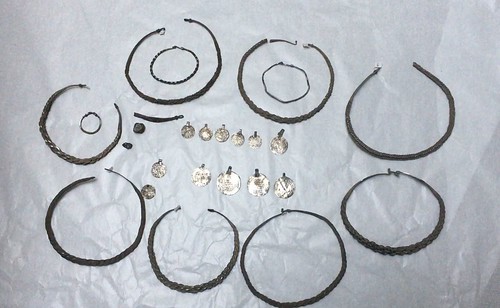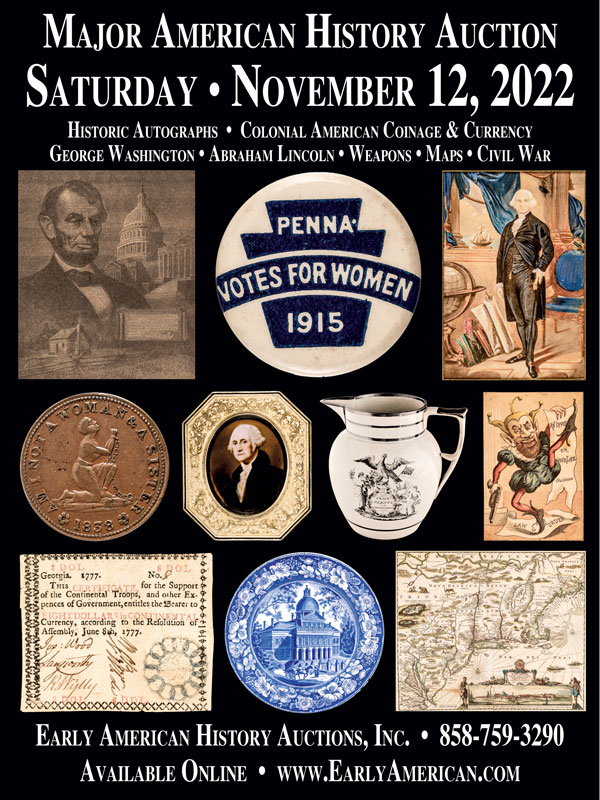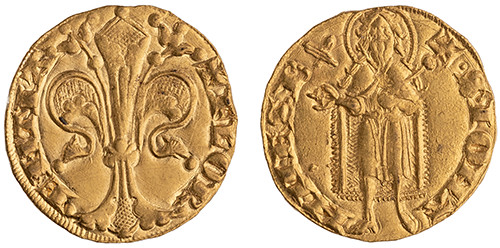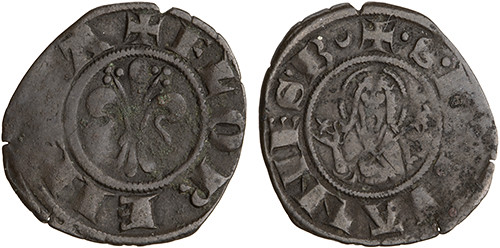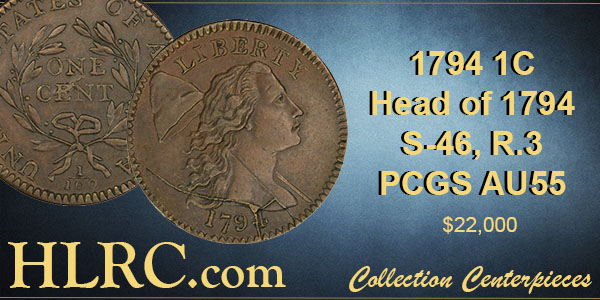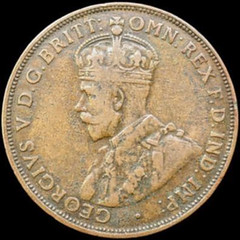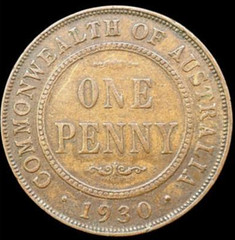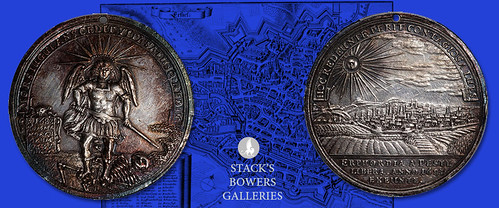
Visit our NBS Sponsors



About UsThe Numismatic Bibliomania Society is a non-profit association devoted to the study and enjoyment of numismatic literature. For more information please see our web site at coinbooks.org SubscriptionsThose wishing to become new E-Sylum subscribers (or wishing to Unsubscribe) can go to the following web page link MembershipThere is a membership application available on the web site Membership Application To join, print the application and return it with your check to the address printed on the application. Print/Digital membership is $40 to addresses in the U.S., and $60 elsewhere. A digital-only membership is available for $25. For those without web access, write to: Charles Heck, Treasurer AsylumFor Asylum mailing address changes and other membership questions, contact Chuck at this email address: treasurer@coinbooks.org SubmissionsTo submit items for publication in The E-Sylum, write to the Editor at this address: whomren@gmail.com BUY THE BOOK BEFORE THE COINSale CalendarWatch here for updates! |
- WAYNE'S WORDS: THE E-SYLUM NOVEMBER 6, 2022
- S.S. CENTRAL AMERICA ARTIFACT CATALOGS
- CHINESE EDITIONS ON ORIENTAL NUMISMATICS
- OCCASIONAL NUMISMATIC PAPERS NO. 2
- BOOK REVIEW: MORGAN SILVER DOLLARS, 7TH
- U.S. MINT FIXED PRICE LISTS ON NEWMAN PORTAL
- VIDEO: LISOT DIVES FOR ATOCHA TREASURE
- MONEY OF THE HOLOCAUST PRESENTATION
- REMINDER: NOVEMBER 2022 NNP SYMPOSIUM
- MORE ON THE "CAPTAIN OF KÖPENICK" TOKEN
- NOTES FROM E-SYLUM READERS: NOVEMBER 6, 2022
- ASTRONOMICAL HISTORY IN NUMISMATICS
- GUY FAWKES DAY NUMISMATICS
- VOCABULARY TERM: MECHANICAL DOUBLING
- DOUBLED DIES VS. MACHINE DOUBLING
- PURNIE MOORE (1907-2008)
- SYD MARTIN PART II AUCTION AND TRIBUTE EVENT
- NUMISMAGRAM SELECTIONS: NOVEMBER 2022
- DAVISSON'S E-AUCTION 45 ANCIENTS
- DAVISSON'S E-AUCTION 45 TOKENS
- COLIN POWELL MEDALS, MEMENTOS UP FOR SALE
- SELECTED GENERAL COLIN POWELL MEDALS
- S.S. CENTRAL AMERICA BANKNOTES OFFERED
- NUMISMATIC NUGGETS: NOVEMBER 6, 2022
- THE AMAZING ATHENIAN TETRADRACHM
- APHRODITE ZODIAC MEDALLION FOUND IN RUSSIA
- SWEDISH CACHE OF VIKING SILVER FOUND
- HOW MUCH IS THAT IN DOLLARS?
- 1930 AUSTRALIAN PENNIES COME TO MARKET
- COMMEMORATIVE MEDAL ON THE BLACK DEATH
- CANADIAN WAR MUSEUM ADDS VICTORIA CROSS
- LOOSE CHANGE: NOVEMBER 6, 2022
Click here to read the thin version on the web
Click here to subscribe
Click here to access the complete archive
To comment or submit articles, reply to whomren@gmail.com
Content presented in The E-Sylum is not necessarily researched or independently fact-checked, and views expressed do not necessarily represent those of the Numismatic Bibliomania Society.
WAYNE'S WORDS: THE E-SYLUM NOVEMBER 6, 2022
 New subscribers this week include:
Mark Chamberlin, courtesy John and Nancy Wilson;
Chris Jones, courtesy Mike McNeil; and
Charles Derby.
Welcome aboard!
New subscribers this week include:
Mark Chamberlin, courtesy John and Nancy Wilson;
Chris Jones, courtesy Mike McNeil; and
Charles Derby.
Welcome aboard!
Thank you for reading The E-Sylum. If you enjoy it, please send me the email addresses of friends you think may enjoy it as well and I'll send them a subscription. Contact me at whomren@gmail.com anytime regarding your subscription, or questions, comments or suggestions about our content.
This week we open with two new catalogs, two new books, Occasional Numismatic Papers number two, and updates from the Newman Numismatic Portal too.
Other topics this week include U.S. Mint fixed price lists, money of the Holocaust, astronomy and Guy Fawkes in numismatics, machine doubling, Purnie Moore, Syd Martin, Gen. Colin Powell, Athenian tetradrachms, a Zodiac medallion, and Viking silver.
To learn more about Oriental numismatics, Morgan Silver Dollars, the Atocha treasure, remnants of the Newman Collection, Harry Houdini, 1864-L Indian Head Cents, chronograms, cabinets of the Vertuosi, Conjugal Duties coppers, British trade tokens, the Order of the Rising Sun, banknotes from the S.S. Central America, the 1964-D Dollar, Build-A-Bear for money nerds, and coins dropped from the top of the Empire State Building, read on. Have a great week, everyone!
Wayne Homren
Editor, The E-Sylum
S.S. CENTRAL AMERICA ARTIFACT CATALOGS
Holabird Western Americana Collections LLC is offering catalogs for their upcoming sales of artifacts recovered from the wreck of the S.S. Central America. See another article elsewhere in this issue for information on the sale, which includes obsolete banknotes recovered from the ship's safe. -Editor
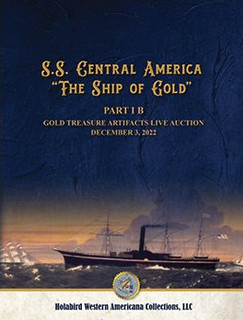 S.S. Central America Artifacts December Auction Catalogs - 2 Piece Set
S.S. Central America Artifacts December Auction Catalogs - 2 Piece Set
$100.00
Our most anticipated auction of the year will be held on Saturday, December 3, 2022, and will be presented in 2 catalogs.
Catalog A features shipwreck artifacts retrieved exclusively from the S.S. Central America The Ship of Gold,
and is presented in a collectors edition spiral bound format inclusive of 3D Glasses and 3D underwater imagery of the spectacular treasure artifacts as they were discovered on the ocean floor.
Catalog B contains complimentary Gold Rush era artifacts including gold, gold pokes, Gold Rush related documents and more.
*If you make a purchase in this auction your catalog purchase of $100 will be refunded or credited to your invoice upon request.
*Catalogs will be shipped directly from the publisher approximately mid-November
For more information, or to order, see:
S.S. Central America Artifacts December Auction Catalogs - 2 Piece Set
(https://www.holabirdamericana.com/shop/p/ss-central-america-december-auction-catalog-set)
CHINESE EDITIONS ON ORIENTAL NUMISMATICS
Scott Semans reports that two important English-language works on Oriental numismatics are being offered in Chinese editions. Great news - thanks. -Editor
From correspondence with the authors I have learned that two important English-language books on Oriental numismatics will be published in Chinese editions.
Ch'ing Cash (2016) by Dr. Werner Burger is being translated and, according to the author's widow, will be printed in the same format and quality as the original. This oversized slipcased work contains a detailed, illustrated history of Qing minting in one volume, and extensive by-year charts for the cash coinage in a second volume. Even with an $800 list price, the edition is nearly sold out and the list price has been raised to $960. The Chinese edition is expected in 2023.
The Historical Cash Coins of Vietnam (2004) by Dr. R. Allan Barker, is the standard work on official cash of the country. Political and numismatic history supplement an extensive variety catalog illustrated with both rubbings and color photos of the cash coins. The Chinese edition has been printed in the same format and quality, and is being marketed in China. I have no information on availability outside China. The original English-language edition is still available from myself and other dealers worldwide.
As a side note, the Barker work is in effect incorporated into the comprehensive series of collector guides to the Oriental square hole" series produced by David Hartill. This consists of Cast Chinese Coins (2005), with a largely unchanged 2nd edition (2017), Early Japanese Coins (2011) which includes non-round gold and silver issues, Cast Korean Coins and Charms (co-author Dr. Wybrand Op den Velde, 2013), Cast Chinese Amulets (2020), and A Guide to Cash Coins (2017), with a comprehensive cross-national finding guide illustrated with actual coins, and a broad sampling of the extensive unofficial Vietnamese series which circulated there, in China, and abroad, along with smaller cash series from Indonesia, Malaysia, and Central Asia. Barker's is the referenced work for official Vietnamese cash in Hartill's finding index. Most of the Hartill works are print-on-demand editions and tend to be readily available.
To visit Scott's website, see:
https://coincoin.com/
OCCASIONAL NUMISMATIC PAPERS NO. 2
Christopher Faulkner and Jacob Lipson recently launched a new online publication on Canadian numismatics called Occasional Numismatic Papers. Issue No. 2 is now available. -Editor
Contents of Occasional Numismatic Papers No. 2
I. Letters to the Editors (page 3)
II. Arithmetical Tables for the Use of Schools by Warren Baker (page 5)
III. Disproving an Alibi (page 8)
IV. LeRoux-1233: The Collége Saint-Laurent Medal by Jacob Lipson (page 9)
V. Breton 919 (1857) ID Markers by Richard Saunders (page 15)
VI. A Note on the Denver Museum of Nature & Science (page 17)
VII. Documents, Artifacts, Photographs: A Letter From Jim Charlton (page 18)
VIII. Uniface Copper Blacksmith Token
Research Help Needed by Jeff Rock (page 19)
IX. Obituaries from Yesteryear: John Gibbs (page 21)
X. Contributor Guidelines (page 23)
The Papers are available through the Newman Numismatic Portal at the following URL: https://nnp.wustl.edu/library/publisherdetail/545751.
If you wish to receive Occasional Numismatic Papers, please contact one of the editors with your email address. Let us know if you do not want to continue receiving the Papers.
Chris Faulkner:
chris.faulkner@carleton.ca
Jacob Lipson:
jacoblipsonrarecoins@gmail.com
To read the issue on the Newman Portal, see:
Occasional Numismatic Papers No. 2
(https://nnp.wustl.edu/library/publisherdetail/545751)
To read the earlier E-Sylum article, see:
PERIODICAL: OCCASIONAL NUMISMATIC PAPERS
(https://www.coinbooks.org/v25/esylum_v25n15a08.html)
BOOK REVIEW: MORGAN SILVER DOLLARS, 7TH
Dennis Tucker of Whitman Publishing passed along this review by Jeff Garrett of the upcoming new edition of the Morgan dollar Guide Book. -Editor
Morgan Silver Dollars is Essential Reading
The seventh edition of Whitman Publishing's best-selling Guide Book of Morgan Silver Dollars, by Q. David Bowers, will debut this December, available from booksellers and hobby shops nationwide. Here, Jeff Garrett, the Senior Editor of the Red Book, reviews the new volume and shares some thoughts on these popular coins.
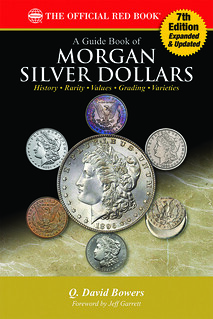 American numismatics closely relates to the historical events of the nation. Nearly every issue of coinage and paper money was created because of important cultural, social, economic, technological, and related developments. No one explores this relationship between numismatics and history like Q. David Bowers. His thoughtful examination brings coins to life and informs the reader of their relevance. Thousands of collectors have been drawn to the hobby by the magic of Bowers's literary brilliance. No other numismatist has had a greater impact on the hobby.
American numismatics closely relates to the historical events of the nation. Nearly every issue of coinage and paper money was created because of important cultural, social, economic, technological, and related developments. No one explores this relationship between numismatics and history like Q. David Bowers. His thoughtful examination brings coins to life and informs the reader of their relevance. Thousands of collectors have been drawn to the hobby by the magic of Bowers's literary brilliance. No other numismatist has had a greater impact on the hobby.
A Guide Book of Morgan Silver Dollars fulfills Bowers's mission of examining these coins date by date and, more importantly, giving the full historical context for their creation. Their deep connection with Western politics of the day makes for interesting reading. Even more compelling is their connection to the settling of the Wild West
and the associated romance of the era.
Morgan silver dollars were produced in prodigious numbers from 1878 to 1921, and vast quantities never entered circulation. While hundreds of millions were relegated to the melting pot because of the 1918 Pittman Act, millions still remain for collectors. The great Treasury Release
in the 1960s and the GSA sale of Carson City silver dollars in the 1970s ensured large numbers would be saved for collectors today. These were two of the most important developments in the history of American numismatics. Bowers gives his readers a ringside seat to these seminal events.
Collecting Morgan silver dollars has changed dramatically over the decades. Many issues were virtually unknown to dealers and collectors until the Treasury release of the 1960s. The advent of third-party grading and population reports in the 1980s has given modern collectors a much clearer indication of true rarity. The current hyper-focus on quality and the popularity of set-registry collecting are other recent phenomena. The data provided by Bowers give collectors the tools to make educated collecting decisions.
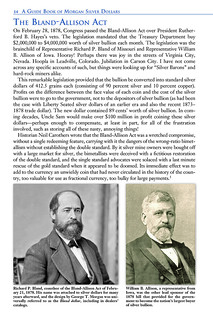 The popularity of Morgan silver dollars has soared in recent years due to the U.S. Mint's production of tribute coins that started in 2021. These new coins were issued to commemorate the 100th anniversary of the last year the coins were struck. The Mint released coins from its facilities in Philadelphia, Denver, and San Francisco, and also produced coins with
The popularity of Morgan silver dollars has soared in recent years due to the U.S. Mint's production of tribute coins that started in 2021. These new coins were issued to commemorate the 100th anniversary of the last year the coins were struck. The Mint released coins from its facilities in Philadelphia, Denver, and San Francisco, and also produced coins with privy marks
representing the now dormant Carson City and New Orleans Mints. Excitement around these new issues has inspired thousands of beginning collectors and energized those already involved with the series.
Morgan silver dollars have long been among the most actively collected U.S. coins. They can be collected on a modest budget by those satisfied with lower-grade examples. For collectors seeking the finest, Morgan silver dollars represent an incredible challenge. Many dates are nearly unknown in superb condition. Bowers's date-by-date analysis gives collectors the information they need, regardless of the quality they choose to pursue.
A Guide Book of Morgan Silver Dollars also gives insider tips on collecting that can only be garnered through decades of experience. Over the course of his career, Q. David Bowers has handled most of the finest known examples, including coins owned by Norweb and Eliasberg and other great collectors. His incredible insight has assisted collectors at every level for more than 60 years. No American numismatic library is complete without the latest edition of A Guide Book of Morgan Silver Dollars.
A Guide Book of Morgan Silver Dollars, seventh edition
By Q. David Bowers; foreword by Jeff Garrett
ISBN 0794849164 • 6 x 9 inches, softcover, 336 pages, full color • Retail $24.95 U.S.
URL:
https://whitman.com/guide-book-of-morgan-silver-dollars-7th-edition/
To read the earlier E-Sylum article, see:
NEW BOOK: MORGAN SILVER DOLLARS, 7TH EDITION
(https://www.coinbooks.org/v25/esylum_v25n41a02.html)
U.S. MINT FIXED PRICE LISTS ON NEWMAN PORTAL
Newman Numismatic Portal Project Coordinator Len Augsburger provided this report on U.S. Mint Fixed Price Lists. Thanks. -Editor
U.S. Mint Fixed Price Lists on Newman Portal
The U.S. Mint has been issuing fixed price lists since at least 1859, when a set of proof master-coins
(face value $41.50) was offered at $43.00. As current U.S. Mint customers are well aware, a single order from the present-day Mint will result not only in coins, but also a long string of print solicitations offering yet more product. The coins are nearly all saved; the print pieces not so much. At Newman Portal we've been accumulating a virtual
collection of U.S. Mint fixed price lists, and currently have 24 examples in our collection, dating from 1859 to 2017. We are sure many more exist and would welcome a loan of any such accumulations for scanning purposes.
Image: Offering of proof coins and medals from the U.S. Mint, c. 1890s.
Link to U.S. Mint fixed price lists on Newman Portal:
https://nnp.wustl.edu/library/publisherdetail/512757
Can anyone help? There must be more of these out there somewhere - help us find them! -Editor
VIDEO: LISOT DIVES FOR ATOCHA TREASURE
The David Lisot Video Library on the Newman Numismatic Portal can be found at:
https://nnp.wustl.edu/library/multimediadetail/522852
We highlight one of his videos each week in The E-Sylum. Here's one from 1985 where David talks about his adventure diving for treasure coins. -Editor
Financial News Network: Consumer Corner 10-23-85
FNN's Eva Dorn interviews David Lisot about his part on the dive on the Atocha treasure ship. David takes calls from a national audience to answer questions about coin collecting.
What a great adventure! At one point in the video, David is shown sitting on a stack of recovered silver bars with a then-current melt value over $5 million. Check it out, cheesy pirate flag, 1980s state-of-the-art computer and all. And like other episodes of the show, there is a call-in segment where David answers audience questions about collectibles. -Editor
To watch the complete video, see:
https://nnp.wustl.edu/library/book/584181
MONEY OF THE HOLOCAUST PRESENTATION
The Eric P. Newman Numismatic Education Society (EPNNES) sponsors more than just the Newman Numismatic Portal. In today's MPC Gram Steve and Ray Feller recounted their experience presenting a talk on money of the Holocaust at Washington University in St. Louis. With permission, we're republishing their report here. -Editor
Money of the Holocaust: A presentation by Steve and Ray Feller
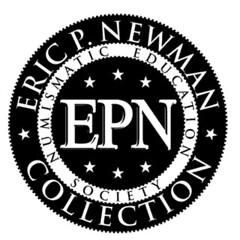 Sponsored by the Newman Educational Foundation and Olin Library Special Collections Division, Washington University
Sponsored by the Newman Educational Foundation and Olin Library Special Collections Division, Washington University
Per the announcement to invitees: This presentation will explore forms of money used in World War II concentration and internment camps, and will reveal how money was used to control prison populations, as well as its use as a tool of propaganda.
The Fellers were introduced by Leonard Augsburger, Project Coordinator for the Newman Numismatic Portal (NNP) project. Addressing an audience of both numismatists and non-numismatists, Ray and Steve held the attention of all for over an hour with a combination of history and stories of the people behind the money. Chits, notes, and a few coins from all theaters of the war were shown in a flying tour of WWII camp numismatics.
Left: Steve and Ray Feller receiving Numismatic Ambassador award
Right: Olin Library "Stories from World War II" Exhibit
In attendance were Festers Dave Frank, Joseph and Louise Boling, and Coin World Senior editor [world coins] Jeff Starck, as well as numerous others with an interest in World War Two history, numismatics and financial history, or just good stories. The Fellers' presentation was given in conjunction with an exhibit in the Newman Tower of Collections and Exploration, John Olin Library, Stories from World War II,
featuring items from several WWII related personal collections, including material from Joseph Boling and the Fellers.
Prior to the talk, we enjoyed a fascinating and eye-opening tour of the Washington University facility that does all the digitization for the Newman Numismatic Portal, as well as for the university (course catalogues, campus flyers, etc,) as well as a significant amount of other numismatic work. We saw images from the hundred-year archives of a western Pennsylvania coin club that had recently been digitized at this facility. Introducing us to the capabilities of her domain was Kim Dumas, Library Technical Assistant to the NNP project and her staff.
There are three large scanners in routine use. Between them there is the capacity to scan books, magazines, full size newspapers, posters, and maps – pretty much anything a client might want. Following that, we walked over to the offices of the Newman Portal, where we saw what Len called the remnants
of the Newman Collection – material ranging from mundane to quite fascinating, and all of it actual, physical objects that had been handled by Eric Newman. Though much of it will be digitized, there is still something to be said for having history in your hand,
material coming to you from another human being.
The evening was capped off by a great evening meal of fellowship with the Fellers, Dave Frank, Jeff Starck, Len Augsburger and his wife and parents, as well as the Bolings. Many stories were told, numismatic and otherwise. The evening ended with happy anticipation of Fest and other get-togethers in the future.
The MPC Gram is an email newsletter for collectors of Military Payment Certificates and other military numismatica. To subscribe to the MPC Gram, see: https://guide.us13.list-manage.com/subscribe?u=10eb366ab80344a56657e0d5d&id=58874b37e1 . -Editor
REMINDER: NOVEMBER 2022 NNP SYMPOSIUM
And don't forget the upcoming NNP Symposium taking place November 17-19, 2022. See the links below for more information on topics and presenters. -Editor
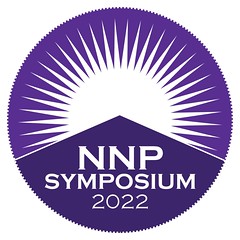 The NNP Symposium is a free, online event that brings together a variety of numismatic speakers and covers a wide array of numismatic subjects. Featuring approximately 25 presentations, attendees will easily find topics of interest. This is the fifth such event, which was launched in fall 2020 in response to the pandemic.
The NNP Symposium is a free, online event that brings together a variety of numismatic speakers and covers a wide array of numismatic subjects. Featuring approximately 25 presentations, attendees will easily find topics of interest. This is the fifth such event, which was launched in fall 2020 in response to the pandemic.
In the area of U.S. coins, our feature presentation will cover U.S. material in the cabinet of the American Numismatic Society (ANS). The ANS holdings in this area are both substantial and surprising. The financier J.P. Morgan made sizable donations to the ANS collection in the beginning of the 20th century, and over time many others have additionally contributed to this important New York repository. Jesse Kraft, the ANS Resolute Americana Assistant Curator of American Numismatics, will be on hand to answer audience questions following this presentation.
Representing another important institutional collection, Benjamin Hellings, the Jackson-Tomasko Associate Curator of Numismatics at Yale University, will also be presenting. Yale recently opened a new space, the Bela Lyon Pratt Gallery, to exhibit materials from one of the oldest collections in the United States. Among other speakers, Chris McDowell will share new details from his continuing research on the Betts medal series, while Kevin Vinton of Stack's Bowers will present highlights of the incomparable Syd Martin collection. Matthew Tavory, representing the next generation of numismatists, will speak on coins and the history of the Revolution. Also appearing will be John Albanese, who will discuss the new CAC Grading service and answer attendee questions on this newly-formed venture.
I'll be participating as part of a panel on Saturday, November 19th at 1 PM EST. -Editor
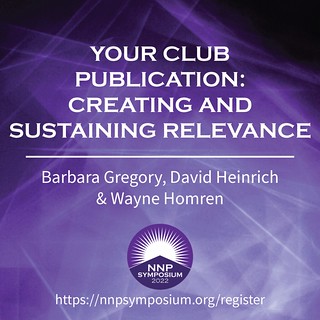 "Your Club Publication: Creating and Sustaining Relevance"
"Your Club Publication: Creating and Sustaining Relevance"
In this open forum, three experienced hobby editors—Wayne Homren (E-Sylum), David Heinrich (The Cincinnati Numismatist) and Barbara Gregory (The Centinel, The Numismatist)—will share their knowledge and tips for engaging club members/readers, as well as ensuring the continued relevance and value of your club's publication. Following the hour-long discussion, the panel will entertain questions from viewers.
To register for the November 2022 NNP Symposium, see:
https://nnpsymposium.org/
For the November 2022 NNP Symposium schedule, see:
https://nnpsymposium.org/schedule
To read the earlier E-Sylum article, see:
NOVEMBER 2022 NNP SYMPOSIUM ANNOUNCED
(https://www.coinbooks.org/v25/esylum_v25n40a07.html)
MORE ON THE "CAPTAIN OF KÖPENICK" TOKEN
Henk Groenendijk shared these thoughts on the "Captain of Köpenick" token mentioned last week. Thanks. -Editor
It was surprised to see a token (Stephen Album Rare Coins Lot 1340) I have in my collection presented in last week's E-Sylum. But I was really astonished by its attribution to the German Schutzgebiet
of Kiau Chau. As far as I know the token is from Berlin, Germany. It is described as number 418 in the book Berlin Marken und Zeichen
by W. Hasselman (1987).
Several varieties are listed in this catalog and also the portrait is identified as that of Wilhelm Voigt, better known as the "Hauptmann von Köpenick" (Captain of Köpenick). The issuer of the token is given as Paul Herpich, owner of a Konfektionsgeschäft
(Clothing Store). The reference given in the auction description is Menzel-4287.1.2. This obviously refers to „Deutschsprachige Notmünzen und Geldersatzmarken im In- und Ausland by Peter Menzel.
Several editions of this catalog have been published, the first one in 1982 (Transpress Verlag Berlin). Checking the „Erste digitale Ausgabe 2014 the catalog number 4287 refers to a completely different token however. Several slabbed specimens of the token can be found on the internet. The ones graded by PCGS all have the Menzel-4287.1.2 reference while those graded by NGC have as a reference Menzel-2951.4. This latter reference is the correct one. The attribution given by Menzel is the same as given by Hasselmann although Menzel does not identify the portrait.
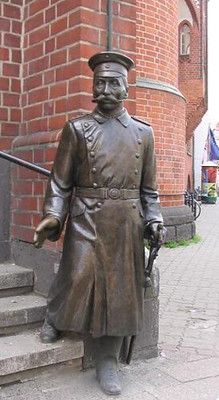 Right:
Statue of the
Right:
Statue of the Hauptmann von Köpenick
in front of the Köpenick Town Hall, erected in 1996 (Photo Wikipedia)
The earliest listing using the Menzel 4287.1.2 reference I found is in the description of Lot #26403 in the Heritage 2012 September 6-11 Signature World & Ancient Coin Auction - Long Beach. The description reads as follows:
Berlin Issued Token for Kiau Chou, Menzel 4287.1.2 but apparently not listed by Schimmel nor Berlus. P H may stand for Paul Herpich. The circulating value as a Wert Marke was 10 Pfennig and the piece was apparently issued early in the 20th century. Medal is nickel-plated brass. This attribution is strictly based on Dana's notations and the rarity rating is his (my highlight). EF with much luster but with the plating rubbing off on the high points of the bust. From The Dana Roberts Collection and Study Group.
No arguments for the Kiau Chau attribution are given. In fact there are arguments against such an attribution:
- The currency in use in Kiau Chau was the Mexican (Chinese) dollar, divided into 100 cents. The coins issued for Kiau Chau, dated 1909, are denominated in cents (KM #1 and 2);
-
All tokens issued for Kiau Chau, with a stated denomination, have
cents
.
Also the token is not listed in Marken und Token der ehemaligen deutschen Kolonien
by Nils Leipner (2016);
It seems proper to use the portrait of the "Hauptmann von Köpenick on a clothing store token as after returning to Berlin he bought a set of civilian clothes. Also the whole episode is an apt illustration of the saying Clothes make the man
. In fact the clothing store issuing the tokens may well have been the actual one where he bought his new outfit. I did not find any documentation supporting this but the store was located not far away from the Neue Wache
where he watched, in a nearby café, how the Mayor and chief cashier he arrested in Köpenick, were brought there.
This, not uncommon token, certainly is quite interesting but cannot be attributed to Kiau Chau.
Thank you! I reached out to Stephen Album Rare Coins Chief Operations Officer Mike Barry who reported that the company was aware of the dubious attribution and had prepared comments on lots to be listed in later auctions but due to a copy/paste error it didn't appear on the lot published last week, They agree that these are likely not China and have amended the lot description as follows. -Editor
A number of these tokens have been attributed to Kiau Chau recently by grading companies and various auction houses. In our opinion the attribution is tenuous and it is more likely strictly a Berlin token issue.
Mike provided these links for reference. Thank you. -Editor
https://www.ngccoin.com/census/world/china-provincial-period/sc-76/10p/?c=406163&des=MS&grade=62&from=ngcresearch
https://www.pcgs.com/valueview/kiau-chau/early-20th-c-tk10-pfg-menzel-4287-1-2-ni-plated-brass/1062?sn=682050&h=pop
https://www.ha.com/c/search-results.zx?N=0+790+231&Ntk=SI_Titles-Desc&Nty=1&Ntt=kiau+chau+token&limitTo=all
https://archive.stacksbowers.com/?q=87e791fa-a182-43d6-be9c-5b2e2249d189
To read the earlier E-Sylum article, see:
STEPHEN ALBUM INTERNET AUCTION 18
(https://www.coinbooks.org/v25/esylum_v25n44a15.html)
NOTES FROM E-SYLUM READERS: NOVEMBER 6, 2022
Outstanding Club Publication Award
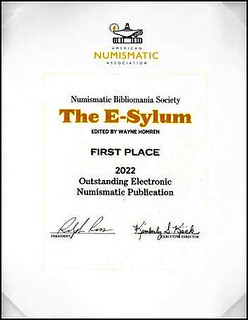 An The E-Sylum subscriber writes:
An The E-Sylum subscriber writes:
"Today I received the November 14, 2022, issue of Coin World. I see on page 10 that The E-Sylum received first place in the Barbara J. Gregory Outstanding Club Publications competition. Boy that Numismatic Bibliomania Society must be a great club to produce such a publication. My congratulations go out to you and to all your fine contributors who submit articles each week."
NBS is indeed a great club and our contributors are the best. We couldn't do it without their dedicated participation. Thanks, everyone! -Editor
To read the earlier E-Sylum article, see:
ASYLUM AUTUMN 2022 ISSUE PUBLISHED
(https://www.coinbooks.org/v25/esylum_v25n37a02.html)
Halloween-themed Houdini Medal
"Legendary magician Harry Houdini, a rabbi's son born in 1874, died on this day in 1926. An annual gathering of the American Society of Magicians, held every Oct. 31 at his gravesite at Machpelah Cemetery in Glendale, Queens, is canceled today because vandals have desecrated his grave on recent Halloweens.
"The Jewish-American Hall of Fame inducted Houdini in 1996. Medal shown by Hal Reed. They are sold out."
Sorry to hear about the vandalism. A great Halloween tradition, though, and hopefully it will resume. There are plenty of spooky-looking tokens and medals, but are there others with a specific Halloween theme? -Editor
David Lisot Funeral Services Livestreamed
Remember, funeral services for David Lisot will be held tomorrow (Monday, November 7, 2022), at 10:30 am (central time) at St. Joseph Catholic Church, 600 S. Jupiter Rd., Richardson, TX 75081. -Editor
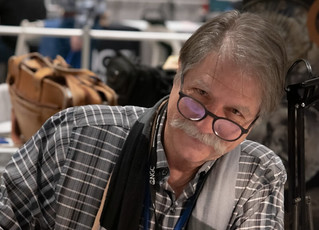 Bill Rosenblum writes:
Bill Rosenblum writes:
"There is a much more extensive obituary for David as well as the livestream link at:
https://www.dignitymemorial.com/obituaries/dallas-tx/david-lisot-10971926
"
The funeral service will be livestreamed at this link: https://vimeo.com/765134230 -Editor
To read the earlier E-Sylum articles, see:
DAVID LISOT (1953-2022)
(https://www.coinbooks.org/v25/esylum_v25n43a08.html)
MORE ON DAVID LISOT
(https://www.coinbooks.org/v25/esylum_v25n44a07.html)
Indian Head Cent Find
James Haas writes:
"Thanks for the latest issue that I enjoyed and found very interesting including Daniel Fearon's comment and your reply.
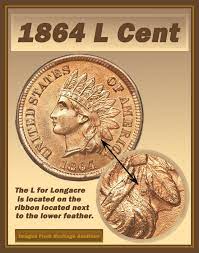 "Seeing the Indian Head Penny article reminded me of a story from my college years 1961-1965. I was doing yard work for a woman who when I finished my task, told me she didn't have any dollar bills to pay me, but asked if I would be okay with a tin box filled with said pennies. I accepted them and mentioned them to my then girlfriend's father. He had a coin collection and expressed interest in two 1864-L coins in what I would have thought fine condition.
"Seeing the Indian Head Penny article reminded me of a story from my college years 1961-1965. I was doing yard work for a woman who when I finished my task, told me she didn't have any dollar bills to pay me, but asked if I would be okay with a tin box filled with said pennies. I accepted them and mentioned them to my then girlfriend's father. He had a coin collection and expressed interest in two 1864-L coins in what I would have thought fine condition.
"He also knew that I was looking to buy my first car, a 1955 Plymouth Savoy, turquoise & black and had been told it would cost me $100.00. Asking me if I would take $50.00 for both, I readily agreed, bought the car and drove it to the 8/28/63 March on Washington stopping every hour or so to ask the attendant to fill the oil and check the gas. LOL.
"In later years I researched the coins, saw their true value and learned a lot about the man who could have been my father-in-law. The current value list you included bears out what I learned back when."
Great story. We have a number of readers who have been in the hobby for decades. Share some of your stories with us? Any trades or sales that went particularly well or badly? -Editor
Image references:
https://www.pcgs.com/coinfacts/coin/1864-1c-l-ribbon-bn/images/2079
https://www.cointalk.com/threads/1864-l-indian-head-cent.148423/
To read the earlier E-Sylum articles, see:
NOTES FROM E-SYLUM READERS: OCTOBER 30, 2022 : Hopi Prayer for Rain Medal
(https://www.coinbooks.org/v25/esylum_v25n44a08.html)
HAYDEN 2022 TOKEN AUCTION SELECTIONS : Lot 11: Indian Head Brockage Error
(https://www.coinbooks.org/v25/esylum_v25n44a17.html)
ASTRONOMICAL HISTORY IN NUMISMATICS
Mike Marotta writes:
"I had a placement about collecting numismatic and philatelic topic themes in Issue #100 of the History of Astronomy semi-annual newsletter. See pages 20-24.
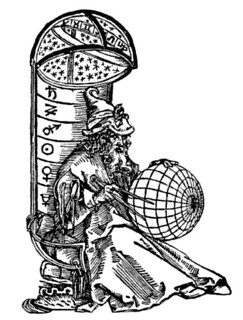 "Since February 2020, I have been a volunteer editor with the History of Astronomy Division of the American Astronomical Society. I am responsible for a column, "This Month in Astronomical History." The articles publish first in AAS News and then are placed on the HAD webpage here:
"Since February 2020, I have been a volunteer editor with the History of Astronomy Division of the American Astronomical Society. I am responsible for a column, "This Month in Astronomical History." The articles publish first in AAS News and then are placed on the HAD webpage here:
https://had.aas.org/resources/astro-history
"In addition to catching other people's subject-verb disagreements and comma splices, I am always looking for writers who want to place about 750 words on a timely celebration of astronomical history in a peer-reviewed publication.
"The AAS is focused on researchers, primary investigators who run programs and hire post-doctoral students and others not as far along in their careers. If you have a doctorate in astronomy and only teach at university, you can be an Educational Affiliate, just as I am an Amateur Affiliate member. That said, though, the AAS is reaching out to a wider audience in the wake of their purchase and rescue of Sky & Telescope magazine, following the demise of F+W Media. They also bought (and saved from extinction) Willmann-Bell, publishers of books targeted to the broad range of hobbyists up to the professional level."
Here's an excerpt. See the complete article online for more. -Editor
With some exceptions, astronomical images seldom appeared on ancient coins of the archaic Hellenic and ancient Hellenistic koine social contexts before the extension of the Roman republic in the second century BCE. Some Roman coins of the Pax Romana early empire do show one or more stars within a crescent Moon, clearly intended to set the time of a notable conjunction though symbolic rather than representational. Easily the most famous examples are the Caesar's Comet with Octavian Augustus on the obverse and a comet on the reverse with the inscription DIVVS IVLIVS referring to the deification of Gaius Julius Caesar following his assassination in 44 BCE.
Broadly accepted by numismatists as markers of an actual event the coins remain putative among astronomers. Stronger acceptance is found for the issues of Tigranes II (Tigranes the Great) of Armenia (140-55 BCE) depicting a prominent star in the king's crown which is correlated to an appearance of Halley's Comet in 82 BCE while Tigranes was extending his empire.
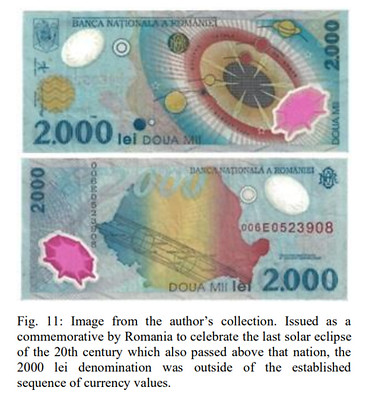 Whereas most national banks and
treasuries maintain legal monopolies on the
issuance of monetary media, the United Kingdom
stands apart in that the obligations of the Bank
of England circulate alongside private issues
from the Royal Bank of Scotland and the
Northern Bank (now Dansk Bank) of Belfast.
The Bank of England one-pound notes of
1978 to 1984 featured Sir Isaac Newton on
the back. He sits with a prism and his reflecting
telescope next to him. In his lap the Principia
Mathematica is open to Proposition XI
Problem VI. An American space shuttle
appeared on the 1999 £5 note of the
Northern Bank. In 2017, the Royal Bank of
Scotland placed Mary Somerville on their current
issue circulating £10 note.
Whereas most national banks and
treasuries maintain legal monopolies on the
issuance of monetary media, the United Kingdom
stands apart in that the obligations of the Bank
of England circulate alongside private issues
from the Royal Bank of Scotland and the
Northern Bank (now Dansk Bank) of Belfast.
The Bank of England one-pound notes of
1978 to 1984 featured Sir Isaac Newton on
the back. He sits with a prism and his reflecting
telescope next to him. In his lap the Principia
Mathematica is open to Proposition XI
Problem VI. An American space shuttle
appeared on the 1999 £5 note of the
Northern Bank. In 2017, the Royal Bank of
Scotland placed Mary Somerville on their current
issue circulating £10 note.
To read the complete newsletter (see pages 20-24), see:
Number 100 * October 2022
(https://had.aas.org/sites/had.aas.org/files/HADN100.pdf)
THE BOOK BAZARRE
GUY FAWKES DAY NUMISMATICS
Well-read numismatists can fairly easily dream up a numismatic connection to just about anything. Yesterday was Guy Fawkes Day in England. Quick - name a numismatic connection. Stumped? Here's some background - a nice summary from The Writer's Almanac. -Editor
Today is the British holiday known as Guy Fawkes Day. Fawkes was born in 1570; he was a tall, well-built man with thick reddish hair and a quick mind. A school friend described him as pleasant of approach and cheerful of manner, opposed to quarrels and strife … loyal to his friends.
Though he had been born and baptized a Protestant, he converted to Catholicism as a teenager, when his widowed mother remarried a Catholic man named Dionis Baynbrigge. When he was 21, he sold his father's estate and went off to Europe to fight with Catholic Spain against Dutch Protestants. While he was in Flanders, he was recruited by a member of what would become known as the Gunpowder Plot: a plan devised by English Catholics to blow up the Houses of Parliament and assassinate King James I, who was a Protestant. The group's leader, Robert Catesby, had heard of Fawkes' military prowess, particularly his expertise with explosives.
So, on November 5, 1605, Fawkes was attending to the 36 barrels of gunpowder that the conspirators had stashed under the House of Lords. Authorities stormed the cellar, tipped off by an anonymous informant, and arrested Fawkes. They tortured him for two days before he gave up the names of his co-conspirators, at which point he was sentenced to death for treason. Traitors were typically hanged, drawn, and quartered — a grisly and slow death — and Fawkes knew this. So, on the day of his execution, he jumped from the gallows, breaking his neck and dying instantly. To celebrate the foiling of the Gunpowder Plot, the king's subjects lit bonfires, shot off fireworks, and burned Guy Fawkes and his fellow plotters in effigy.
I celebrated the day one year in the early 1980s with a group of Brits I worked with at Bell Labs in New Jersey. Fun evening. A crisp fall night, the event was in a backyard with a roaring fire, plenty of snacks and alcoholic punch, and what looked to me like a scarecrow made of old clothes stuffed with newspaper. Later in the evening, the cries began - "Burn the Guy! Burn the Guy!" And they tossed the Guy Fawkes effigy into the flames to much applause and merriment.
A longtime popular symbol of protest, Guy Fawkes masks are often worn at rallies today - see the article linked below for background.
Anyway, I emailed some of our British contributors to wish them a Happy Guy Fawkes Day and not surprisingly, one of them replied with a great numismatic connection, and it's a chronogram to boot. Thank you, David Pickup! -Editor
Terrorist Plot Foiled
Copper jeton or medal which commemorates the foiling of the Gunpowder plot. It is unsigned, and shows a snake gliding among lilies and roses on the reverse with the inscription,
DETECTVS • QVI • LATVIT S • C • which means the concealed one is discovered.
On the reverse is the name of Jehovah written in Hebrew script within a border of thorns. The reverse bears the inscription NON DORMITASTI ANTISTES IACOBI, translating to you, the keeper of James, have not slept.
Some of the letters are slightly bigger than the others. This means the date is written chronogrammatically which means some of letters in Roman numerals add up to the date.
NON DORMITASTI ANTISTES IACOBI
M = 1000
D = 500
C = 100
I x 5 = 5
= 1605
David also has an article in Coin News "Remember Remember the fifth of November" about Thomas Knyvet, Member of Parliament who played a part in uncovering the plot. -Editor
"A tragedy was prevented because the authorities were tipped off and they conducted a thorough search of the cellars. Thomas Knyvet, (sometimes spelt Knyvett) was a Member of Parliament, had a leading part in uncovering the plot. He was a Royal courtier and went on to have an important position and career at the Mint. Thomas Knyvet's link to coins started when he served as Warden of the Royal Mint from 1599 to 1621. He was paid an official salary of £100 plus £20 for his clerk and in 1621 he was joint warden with Edward Doubleday. He was involved in a dispute with a colleague about the quality of coins that lasted for many years and even the King's judges could not sort it out. The argument was with the elderly Sir Richard Martin, who was Master of the Mint and Knyvet's predecessor."
To read the complete articles, see:
The Writer's Almanac for Saturday, November 5, 2022
(https://www.garrisonkeillor.com/radio/twa-the-writers-almanac-for-november-5-2022/)
MASK UP: HOW THE GUY FAWKES MASK BECAME ONE OF THE MOST ICONIC DESIGN OBJECTS IN RECENT HISTORY
(https://archive.pinupmagazine.org/articles/article-guy-fawkes-mask-v-for-vendetta#43)
https://www.tokenpublishing.com/issue/587
(Free Trial Issue)
VOCABULARY TERM: MECHANICAL DOUBLING
Here's another entry from Dick Johnson's Encyclopedia of Coin and Medal Terminology. -Editor
Mechanical Doubling. Tiny lines or offset around the edge of lettering because of loose dies in the coining press. Also called double line by collectors, it shows a shift to one side forming a double outline of letters or numbers near the rim. The phenomenon is not in the die – it is not a doubled die – but is a chattering of a loose die during striking, particularly after a long press run. It has been described as a twisting of the die as it withdraws pulling small metal relief from its fixed position leaving large heavy relief, as a portrait or device, unaffected. It is cleared up by tightening the set bolts in the chucks holding the die in place. Such errors are usually not collected by numismatists because of their minor interest in the field.
A coin with mechanical doubling can be discerned from double die coins by the clarity of the letters or figures. True double die strikes (with a die that has two identical images) have distinctly formed letters, two distinct over-lapping complete letters. Mechanical doubling is a distortion of letters which look misshapen; the top of their letters or figures are smaller than their base, with a movement of the upper part of the letters or figures to one side.
Reference:
NM19 {1991} Margolis, p 321-324.
To read the complete entry on the Newman Numismatic Portal, see:
Mechanical Doubling
(https://nnp.wustl.edu/library/dictionarydetail/516283)
DOUBLED DIES VS. MACHINE DOUBLING
Here's an excerpt from a nicely illustrated 2017 article on the NGC website titled "Doubled Dies vs. Machine Doubling". -Editor
The distinction between genuine die doubling and mechanical doubling can be subtle, but they can easily be differentiated with just a loupe and a bit of knowledge.
One of the more common questions that NGC Customer Service receives is regarding the difference between a doubled die and machine doubling. This distinction is very important, because a doubled die variety may be worth a large premium, while machine doubling is a mere novelty and does not usually add value.
Double dies
A true doubled die is a variety in that it is created during the die making process. As a result, the doubling will appear on every coin struck from that die. In the past, doubled die errors were often much more dramatic due to the process in which dies were created. This method often required multiple impressions from a working hub to impart the detail into a die. If the hub or die shifted at all during this process, the finished die would feature two distinct impressions with separation between them. The design, letters and digits will be doubled.
One of the most famous doubled die coins is, of course, the 1955 Lincoln Cent with a doubled die obverse. It is extremely rare that such dramatic doubling would slip through unnoticed at the US Mint. At the time, the Philadelphia Mint was running two 12-hour shifts in order to help alleviate a cent shortage. At least seven people were supposed to have inspected the die before it was put into use, but that clearly was not the case here. Instead, the die was placed in service for a midnight to 8:00 am shift. The problem was not discovered until some 20,000-24,000 cents had already been mixed in with the millions of other cents struck that night. The Chief Coiner of the Philadelphia Mint, Sydney C. Engel, decided to let the coins through instead of melting a total of approximately 10 million cents to contain them. Those 1955 Doubled Die Obverse Lincoln cents are now one of the most sought-after varieties in coin collecting.
Mechanical doubling
On the other hand, there is mechanical doubling. This type of doubling, which is also known as strike, ejection, shelf or shift doubling, is not the result of the design on the die being doubled. Rather, this type of doubling occurs when the die strikes a planchet. If the die is not properly seated, it can move slightly or bounce during the moment of striking, creating a flat, shelf-like doubling. This effect will be different on all coins struck, so it is technically not a variety, but rather more of a striking error.
Above is an example of machine or strike doubling. Notice how the doubling is very flat in appearance and there are serifs in the letters that are not separated.
Above is another example of a genuine doubled die coin (the 1972 Doubled Die Obverse Lincoln Cent). Notice how there is a clear separation between the serifs on all the letters. This proves that the doubling was created during the hubbing process rather than during the striking of the actual coin
To read the complete article, see:
Doubled Dies vs. Machine Doubling
(https://www.ngccoin.com/news/article/5688/Double-Dies-vs-Machine-Doubling/)
PURNIE MOORE (1907-2008)
American Numismatic Biographies author Pete Smith submitted this article on Alabama numismatist Purnie Moore. Thanks! -Editor
The topic of hundred-year-old numismatists comes up occasionally in The E-Sylum. Apparently, I have become the keeper of the list. I recently added another name that had previously been overlooked.
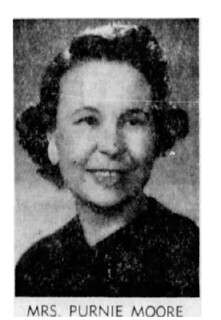 Purnie Estelle Doss was born in Adamsville, Alabama, on August 26, 1907, the daughter of
railroad foreman John Wesley Doss and Olive Bradford Doss.
Purnie Estelle Doss was born in Adamsville, Alabama, on August 26, 1907, the daughter of
railroad foreman John Wesley Doss and Olive Bradford Doss.
She was married in Alabama on June 4, 1927, to Earl Moore. He died of wounds in France on March 17, 1945, during World War II. They had no children. In 1954, Purnie was chapter president of Gold Star Wives and national parliamentarian in 1958.
She worked as a teller and vault clerk at the First National Bank of Birmingham from 1929 to 1969. She Frequently spoke about coins to local organizations.
Purnie Moore was active with several civic organizations. In 1957 she was first vice president and in 1958 to 1959 she was president of the Birmingham Women's Junior Chamber of Commerce. In 1956 she was treasurer and in 1959 she was elected president of the Birmingham Symphony League. She was treasurer of the Birmingham Chapter, American Institute of Banking (1955-1956).
When has a coin collection became too large? Purnie reported that she kept her best coins locked in a vault. The weight of another coin collection stored in her attic caused the kitchen ceiling to fall down.
She joined the American Numismatic Association as member 23161 in 1954 and was recognized as a fifty-year member in 2004. She served the ANA as district representative (1980) and regional representative (1975) and received an ANA Medal of Merit in 1987. She converted to life membership (LM-1722) in 1994. She was not noted as a sixty-year member in 2014. There was no obituary for her published in The Numismatist.
She was secretary (1957) and past president (1961) of the Birmingham Coin Club. She served as General Chairman for the Alabama Numismatic Society shows 1961-1964. Then she was elected treasurer (1964-1965) and executive secretary of the Alabama Numismatic Society promoting club shows (1974-1996). Also on the board and president in 1987 was her cousin Clyde H. Fisher. She served on the U. S. Assay Commission in 1971 and was a member of the Old Time Assay Commission (OTAC). In 1980 she was named a Numismatic News Numismatic Ambassador. She was also a member of the Society of Paper Money Collectors (SPMC).
Purnie Moore died at home at age 100 on May 3, 2008, in Birmingham, Alabama, and is buried at Mount Zion Baptist Church Cemetery in Corner, Alabama.
She is an example of an active volunteer serving on a local or regional level who may not be recognized for service on a national level.
- Dorothy Baber, 100 (1920-2021)
- Carl G. Boehmer, 105 (1906-2011)
- James E. Charleton, 102 (1911-2013)
- Edward Louis Dence, 103 (1917-2021)
- William S. Dewey, 100 (1905-2006)
- Edward Gans, 103 (1887-1991)
- Dr. Jesse C. Green, 103 (1817-1920)
- Robert L Hendershott, 106 (1898-2005)
- Genevieve T. Herdegen, 103 (1886-1989)
- Clyde Hubbard, 104 (1916-2020)
-
Honora
Nora
W. Hussey, 105 (1915-2020) - Robert Hepworth Lloyd, 103 (1906-2009)
- Purdie Estelle Doss Moore, 100 (1907-2008)
- Eric P. Newman, 106 (1911-2017)
- Nellie Tayloe Ross, 101 (1876-1977)
- Carl H. Subak, 103 (1919-2022)
Thanks! A select list we can all aspire to join. I've had the pleasure of meeting Baber, Dence, Hendershott, and Newman in the course of my hobby career.
On a related note, here's a segment from the Stack's Bowers E-Newsletter Vol. 11, No. 44 (November 4, 2022) -Editor
SYD MARTIN PART II AUCTION AND TRIBUTE EVENT
A Stack's Bowers blog article describes a nice event held at the recent Whitman Baltimore Expo in honor of the late Syd Martin. -Editor
During the Whitman Coin & Collectibles Winter Expo last week we hosted two auction sessions showcasing selections from the Sydney F. Martin Collection. It was said that the series featured in these sessions ranked high on the list of Syd's numismatic passions, as did his fellow enthusiasts in the Colonial Coin Collectors Club (C4). Thus, last week's auction venue for Part II of Syd's collection gave us the perfect opportunity to honor our friend and colleague.
The sale itself saw spirited bidding which resulted in numerous price records. The unique 1670-A French Colonies copper double de l'Amerique, the earliest dated coin bearing the word America,
realized an astounding $504,000 – the highest price ever paid for a French Colonial coin. The expansive Rosa Americana offering generated considerable excitement, highlighted by the 1717 Pre-Patent twopence that realized $28,800 – a record for a Pre-Patent Rosa Americana coin – and the famous 1733 twopence Pattern PCGS PR-62 BN that sold for $57,600. The eagerly anticipated 1785 and 1786 Connecticut coppers set many new high-water marks for that series, such as $43,200 for the unique 1785 Miller 6.6-A.3 die variety. Other notable prices realized included those for high-end type coins such as the 1786 Miller 5.3-N Hercules Head PCGS AU-55 at $22,200 and the 1786 Miller 6-K Draped Bust Left PCGS AU-55 at $26,400.
The second session offered a fabulous array of Washingtoniana and there was intense demand for the finest and rarest pieces. Prices realized for Washington Seasons medals reached new heights with the silver versions of The Shepherd and The Home medals realizing $114,000 and $132,000 respectively. The rare Roman Head cent in PCGS Proof-64 RB brought $132,000 and the Funeral Urn medal in gold, PCGS AU-55, realized $66,000.
On Friday, October 28, after the hammer fell on the final lot of the day, we gathered with the C4 group, and some friends and family to share stories about Syd, acknowledge his accomplishments in the colonial coin field and express appreciation for his many contributions to the hobby. C4 created the Sydney F. Martin Memorial Numismatic Publication Award to recognize writers for their contributions to the field of colonial and early American coinage. A medal was created with Syd's image to be presented to the recipients. Craig MacDonald, president of C4, presented to Syd's family, represented at the event by his daughter Jessica, their personal medal.
John Kraljevich led the evening with a discussion about Syd's collections and included a very pertinent quote from Daniel Eccleston to Thomas Jefferson from January 1, 1810:
Those Medals, in all probability, many generations hence, will be preserved in the cabinets of the Vertuosi, when you and I are mouldering in the dust.
It's quite remarkable that we can still touch history in a very up close and personal way through the hobby of numismatics. Here's to Syd, a shining light whose literary works will continue to educate and spark the collecting fires in future generations.
Love that quote - how apt and prescient. Leave it to Kraljevich to find it! -Editor
To read the complete article, see:
SYDNEY F. MARTIN PART II AUCTION AND TRIBUTE EVENT
(https://stacksbowers.com/sydney-f-martin-part-ii-auction-and-tribute-event/)
NUMISMAGRAM SELECTIONS: NOVEMBER 2022
Jeremy Bostwick at Numismagram forwarded along these four highlights from his recent November addition of new material to his website. In addition to the items below, there are some attractively toned German medals, some Hungarian medical-themed medals, and a small-sized Betts medal in silver relating to the Treaty of Hubertusburg and end of the French & Indian War. For all of the new items, please visit https://www.numismagram.com/inventory. -Editor
102097 | FRANCE. "Conjugal Duties" Trials/Father Lustucru satirical copper Jeton. Issued 1660. On the topic of trials alleging impotence and promoting the "re-education" of "deviant" women by Father Lustucru (27mm, 6.71 g, 6h). VNICVS EST S[P]ECIE (he is unique in appearance...), two blacksmiths standing around anvil, both hammering and with one holding head of woman with pincers upon anvil / OMNE FERENS MALVM (...bearing all that is evil), monkey, holding whip and reins, riding donkey left and bearing basket filled with heads of women. Feuardent 9608; Neumann 39921; Mitchener 3489-91 (though erroneously described as a type pertaining to the many wars of Louis XIV). Choice Extremely Fine. Glossy brown surfaces, though a few minor edge bruises noted for completeness. $495.
If one thinks that the explosion of reality TV of our era, with its poking and prodding into the private lives of some merely for the morbid curiosity of others, is actually anything new, it may come as a surprise that, in fact, it is not. In 17th century France, for instance, married couples were required, by law, to "perform their conjugal duties" with one another, submitting on demand for one partner to the other. In the instance of male impotence, such duties obviously created an impossible task for the husband, and one for which he could be tried for committing a larcenous act. The wife, who may wish to seek a divorce, could bring about a trial that would subject the couple to bedroom inquisitions and every type of examination to determine what exactly did, and did not, function properly. Needless to say, such trials were publicized, making them a voyeuristic forerunner to the most salacious stories of today.
One such instance, and quite possibly the most famous, involved a French nobleman, René de Cordouan, the Marquis de Langey, who married Mademoiselle Marie de St Simon de Courtemer in 1653. Their marriage is described as happy for the first four years, though Madame Langey charged her husband with the claim of impotence in 1657, causing much in the way of examination into their intimate lives and bodies as well. The court found both husband and wife physically capable, though Madame Langey nevertheless insisted in the inadequacies of the Marquis, causing him to seek her damning allegations to be disproven so that his good name (and abilities) would be cemented in the eyes of the heavily invested public. His Trial by Congress, however, was not successful, as it was required that the couple submit to a private bathhouse for an evening, with a not-so-private jury of 15 individuals (five surgeons, five physicians, and five matrons) there to observe any fulfillment of conjugal duties. The Marquis, likely on account of the prying eyes all around, was unable, condemning his reputation and granting unto his wife a legal dissolution of their marriage. It is interesting to note that, years later, the Marquis would marry again, this time to Diana de Montault de Navaille, with whom he would father seven children.
Given the nature of these allegations and subsequent trials, it seems obvious that some men become highly suspicious of "deviant" women who would use such a legal means as a way in which to seek a new marriage (and destroy their aura of masculinity). It was around this time that a mythical figure, Father Lustucru, appears in writings and engravings, with the goal of "re-educating" women who were seen as rebellious or hysterical to the patriarchy. This figure was presented in the setting of a blacksmith, with the severed heads of women being beaten with hammers upon anvils in an attempt to "cure" them of their wicked and wild ways. A simian-like creature, usually a monkey, was employed to ride a donkey, collecting the heads of various women in satchels and bringing them to Lustucru's forge for such "corrections," with a sign above his shop bearing some form of the phrase "the best woman is one without a head."
That's harsh. An episode of history I missed out on learning about in school. -Editor
To read the complete item description, see:
102097 | FRANCE. Conjugal Trials/"Between the Sheets" satirical copper Jeton.
(https://www.numismagram.com/product-page/102097)
102125 | GREAT BRITAIN. Queen Anne white metal Medal. Issued 1711. The Concord of Britain (44mm, 27.54 g, 12h). By P. H. Müller. ANNA D G MAG BR FR ET HIB REGINA, draped bust left / DVLCE MELOS VNITA SONAT (in unison she produces sweet harmony, [the larger letters indicating the date in a chronogram]), harp left, with top terminating in head of cherub; CONCORDIA BRI–/TANNORVM in two lines in exergue. Edge: Plain. MI 386/238; Eimer 451. Choice Mint State. Extremely brilliant and prooflike. $345.
The concord represented on the reverse of this medal likely refers to the brief cessation in hostilities for Britons, in that there was an aim to end participation in the conflict involving so much of Europe, that of the War of Spanish Succession, upon the death of then-Emperor, Joseph I, in 1711. Beginning with the death of the childless Carlos II (Charles), the last of the Spanish Habsburgs, a power struggle ensued, with claimants hailing from France and Austria. Ultimately, the crown of Spain would pass to the Bourbons of France, with the new Spanish monarch (Felipe) renouncing his line in the French succession, while that of the Holy Roman Empire would stay with Habsburgs.
Nice medal, and cool chronogram. -Editor
To read the complete item description, see:
102125 | GREAT BRITAIN. Queen Anne white metal Medal.
(https://www.numismagram.com/product-page/102125)
102169 | FRANCE. Compagnie de Navigation Sud-Atlantique Art Deco bronze Medal. Issued 1931. Commemorating the maiden voyage of the "Atlantique" service line (68mm, 148.44 g, 12h). By L. Bazor in Paris. Venus, holding trident, in facing marine quadriga pulled by four sea horses / COMPAGNIE DE NAVIGATION SUD–ATLANTIQUE, perspective view from the right of the vessel breaking waves left; L'ATLANTIQUE / 1931 in exergue. Edge: «cornucopia» BRONZE. Choice Mint State. Charming brown surfaces, with some lighter highlights and pleasing relief; a few scattered marks are noted merely for completeness. An exceptional Art Deco design by an ever-popular medalist. Rare, especially this attractive. $365.
The grandest and most luxurious passenger ship on the Europe–South America line, the Atlantique herself was in operation for little over two years, with her maiden voyage occurring in September/October 1930, and her demise—caused by a fire while in the English Channel—happening in January 1933. The Art Deco motif of this medal conveys the nature of the ship's interior design, which was heavily influenced by the style
Great medal! -Editor
To read the complete item description, see:
102169 | FRANCE. Compagnie de Navigation Sud-Atlantique Art Deco bronze Medal.
(https://www.numismagram.com/product-page/102169)
102230 | ITALY. Vatican City. Pope Saint Ioannes XXIII silver Medal. Issued 1961/Year III. The canonization of Gregorio Barbarigo (44mm, 36.36 g, 12h). By P. Giampaoli in Rome. IOANNES • XXIII • PONT • MAX / AN • III, bust left, wearing camauro, mozzetta, and stole / SANCTVS • GREGORIVS • BARBADICVS, St. Gregorio seated facing at desk, wearing stole, biretta, and nimbus crown, and holding quill; in two lines in exergue, 26-V / AN • D • MCMLX. Edge: E•988. Bartolotti E961; Modesti 96; Rinaldi 155. Choice Gem Mint State. Highly brilliant and prooflike, with a deep iridescence spread mostly throughout. Includes box of issue. Mintage: 4,300. $225.
A cardinal in the Roman Catholic Church who served as Bishop in both Bergamo and Padua, he was greatly revered for pastoral initiatives and scholarly learnings, as well as visitations within his ecclesiastic dominions. Given his strong standing within the Church hierarchy, he was considered a frontrunner to become Pope during the papal conclaves of 1689 and 1691. He was beatified in 1761 under Pope Clemens XIII (Clement), and was finally canonized, as celebrated on this medal, in 1960 under Pope Ioannes XXIII (John), who himself would later be canonized in 2014 under current Pope Franciscus (Francis).
Nice medal. Bibliophiles will appreciate the bookshelves in the background. -Editor
To read the complete item description, see:
102230 | ITALY. Vatican City. Pope Saint Ioannes XXIII silver Medal.
(https://www.numismagram.com/product-page/102230)
DAVISSON'S E-AUCTION 45 ANCIENTS
Davissons Ltd shared these selections from the firm's upcoming E-Auction 45. -Editor
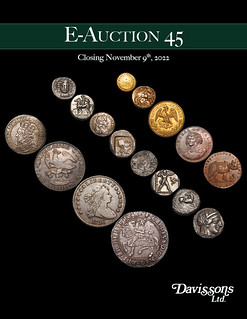 Our Greek offering is highlighted by several carefully selected consignments. Look for fine silver and bronze from Sicily, Macedon, Thrace, Thessaly, Lycia, and more. Of particular note is the first offering from a collection of classic Larissa facing head issues, and several choice single and small group lots from the Robert Hoge collection.
Our Greek offering is highlighted by several carefully selected consignments. Look for fine silver and bronze from Sicily, Macedon, Thrace, Thessaly, Lycia, and more. Of particular note is the first offering from a collection of classic Larissa facing head issues, and several choice single and small group lots from the Robert Hoge collection.
Our Roman selection opens on several fine Provincial issues, particularly of Augustus and Hadrian. The Republican offering consists of denarii from the Zabel collection, and the Imperial section includes several nice early bronzes of Augustus and Titus, and choice late silver including a rare legionary issue of Gallienus.
A few nice Byzantine pieces conclude the ancients–two well centered early folles on broad even flans, and a well struck silver issue from nearly 1000 years later.
Several noteworthy lots are below, but there is more to see! Do take a minute to browse the whole ancient section.
To read the complete auction ancients section, see:
E-Auction 45 Ancient section
For more information, see:
https://davcoin.com/
To read the earlier E-Sylum article, see:
DAVISSON'S E-AUCTION 45
(https://www.coinbooks.org/v25/esylum_v25n41a24.html)
DAVISSON'S E-AUCTION 45 TOKENS
Allan Davisson also penned an article about some of the great British trade tokens in Davisson's E-Auction 45. -Editor
British trade tokens are the story of the need for small change in daily life when the government was unable or unwilling to provide an official
currency. Tokens for daily trade became a part of British life in England and Wales soon after the death of Charles I. Not much later, Irish tokens became a part of commerce there as well. (The Scots avoided the problem by allowing an extensive issue of base metal coins.)
The governments of the era simply did not issue small change. Until 1696 there was the additional problem of hammered silver lacking full value because of all the clipping of pieces in circulation. Political instability was a major reason. The Civil War disrupted life. The reigns of the sons of Charles I—Charles II and James II—dealt with the turmoil after Commonwealth rule fell apart after the death of Cromwell. Then the Glorious Revolution
when William of Orange, ruler of the Dutch Republic, came to England with his wife Mary, the daughter of James II, and took over the British throne eventually brought some minting stability, and the great recoinage of 1696 brought a substantial issue of silver.
British tokens are a regular feature of our catalogs. My involvement with them goes back to the time when we (Marnie and I) were just beginning to build a numismatics-based business. We attended local and regional coin shows and published fixed-price lists (with no photos). I first saw these copper pieces about the size of a US large cent in boxes that an older part-time coin dealer had on his table at a coin show. For a couple of dollars each I could buy coppers from the American colonial era that came from England and featured wide-ranging designs. Early on, I responded to an ad run by someone whose name I had seen in coin newspapers offering a dozen (or so, as I recall) uncirculated examples of these pieces for something on the order of $100 or $125. When the parcel arrived, there were more pieces than promised, all of which were pretty close to Uncirculated, along with a note that the extras were because he could not provide as many choice pieces as he had advertised. That was my first transaction with David Bowers.
Our offering of British trade tokens in this catalog includes some marvelous pieces from Baldwin's basement I came upon while researching my update of Dalton & Hamer in the 1980's, and others from the iconic Jim Noble Sale I attended in Melbourne in 1998. Provenances of former owners include Cokayne and Richard Doty, former curator at the Smithsonian.
A marvelous Pidcock piece picturing a rhinoceros and an antelope is followed by some Spence tokens that show his influence on the architects of the American Revolution and their fight for freedom and independence across the ocean.
Next follows a lovely group of classic tokens from Wales featuring the iconic Druid's head.
And some classic tokens from Scotland.
A small but satisfying listing with some gems included. Take a look before the sale closes on Wednesday and these modest mementos of the turbulent late 18th century go to their next owners.
To read the complete auction British Tokens section, see:
E-Auction 45 British Tokens section
For more information, see:
https://davcoin.com/
To read the earlier E-Sylum article, see:
DAVISSON'S E-AUCTION 45
(https://www.coinbooks.org/v25/esylum_v25n41a24.html)
COLIN POWELL MEDALS, MEMENTOS UP FOR SALE
The sale of the estate of General Colin Powell includes many medals awarded to him over his long career. -Editor
Colin Powell's career spanned some of the most significant moments of the last 40 years so it's no surprise that an auction of items from his estate reflects that: gifts and medals from foreign dignitaries and presidents, photos of his swearing-in as secretary of state.
But it might be the more whimsical items that better tell the story of what kind of man he was: the Star Wars
lightsaber given to him by George Lucas, a race car helmet, the memorabilia connected to the Buffalo Soldiers, the 19th-century African American Army regiments that Powell championed throughout his career.
In all, nearly 400 items big and small, momentous and mundane, are up for auction with proceeds to benefit the America's Promise Alliance — which Powell once chaired — and the Colin Powell School at the City College of New York, his alma mater.
It's really a capsule of American history in the last four or five decades,
said Elizabeth Haynie Wainstein, owner and president of The Potomack Company, the auction house conducting the estate sale.
The auction is already underway and will run through Nov. 16. Bids can be placed online, and items can be viewed in person at the auction house in Alexandria.
A few items are already proving popular — a Baikal shotgun presented to Powell by Mikhail Gorbachev at a 1988 summit in Moscow had already received a $7,000 bid by Thursday afternoon, well above the $3,000 to $5,000 estimate given by the auction house.
The estimates, though, are for the intrinsic value of the items and do not account for how bidders value the fact that the items belonged to Powell and his wife, Alma.
"That's the unknown thing about provenance and auction," Haynie Wainstein said.
Powell died last year at the age of 84. He served as secretary of state during the first term of President George W. Bush from 2001 to 2005, including the Iraq War. Before that he served as national security adviser in the Reagan administration and chairman of the Joint Chiefs of Staff in the George H.W. Bush administration, when Powell played a key role in the Persian Gulf War.
To read the complete article, see:
Medals, Mementos from Colin Powell Estate Go Up for Auction
(https://www.military.com/daily-news/2022/11/04/medals-mementos-colin-powell-estate-go-auction.html)
THE BOOK BAZARRE
SELECTED GENERAL COLIN POWELL MEDALS
Here are some of the medal lots included in the sale of General Powell's estate. -Editor
Lot 1099: ORDER OF THE RISING SUN MEDAL AND PIN, GRAND CORDON 1ST CLASS, AWARDED TO GENERAL POWELL BY THE JAPANESE GOVERNMENT, 1991
the medal in silver with gold highlights, with white enamel, depicting a rising sun; the medal on the red and white ribbon with purple berries in enamel, with small pin; in black lacquer box with Japanese inscription, the interior in purple silk and velvet (3)
Catalogue note:
Established in 1875 by Emperor Meiji, the Order of the Rising Sun recognizes individuals who have accomplished distinguished achievements in international relations, the promotion of Japanese culture, and the preservation of the environment.
To read the complete lot description, see:
ORDER OF THE RISING SUN MEDAL AND PIN, GRAND CORDON 1ST CLASS, AWARDED TO GENERAL POWELL BY THE JAPANESE GOVERNMENT, 1991
(https://www.potomackcompany.com/auction-lot/order-of-the-rising-sun-medal-and-pin-grand-cordo_4BC4827B6E)
ORDER OF KUWAIT, FIRST CLASS, BREAST STAR AND SASH BADGE, GIVEN TO GENERAL POWELL
in light blue and white enamel, with an eight-point star, the flag of Kuwait, set against a gold starburst, the sash bad of identical design, both with English gold hallmarks for Birmingham; with blue and white sash (2)
To read the complete lot description, see:
ORDER OF KUWAIT, FIRST CLASS, BREAST STAR AND SASH BADGE, GIVEN TO GENERAL POWELL Diameter of largest: 3 1/4 in. (8.26 cm.)
(https://www.potomackcompany.com/auction-lot/order-of-kuwait-first-class-breast-star-and-sash-_8A74A81A5F)
Lot 1110: RONALD REAGAN FREEDOM AWARD TO GENERAL POWELL, MADE BY TIFFANY & CO., 1993
the gilt-silver medal depicting the seal of the President/Ronald Reagan Presidential Library, the border 'Ronald Reagan Freedom Award,' the obverse 'Presented to General Colin L. Powell/Twelfth Chairman of the Joint Chiefs of Staff/November 9, 1993/Los Angeles, California', the medal rim signed 'Tiffany & Co./Sterling/.925', suspended on a purple ribbon; in original fitted blue box
Catalogue note:
The highest honor awarded by the Ronald Reagan Presidential Foundation and Institute, the Ronald Reagan Freedom Award is bestowed upon those who have made monumental and lasting contributions to the cause of freedom.
To read the complete lot description, see:
RONALD REAGAN FREEDOM AWARD TO GENERAL POWELL, MADE BY TIFFANY & CO., 1993
(https://www.potomackcompany.com/auction-lot/ronald-reagan-freedom-award-to-general-powell-mad_F734384AD2)
Lot 1114: CANADIAN MERITORIOUS SERVICE CROSS, TO GENERAL POWELL, 1994
the bar etched with General Powell's name to reverse, the obverse of the medal 'Meritorious Service Meritorie' and the cipher of Queen Elizabeth II; in original fitted case; underside written "Canada" in Powell's hand
Citation:
"By his contribution to American/Canadian relations during his tenure as national security advisor and subsequently as chairman of the Joint Chiefs of Staff Committee; by his assistance to the role played by the Canadian Forces during the Gulf War, to the Canadian battle group at Sarajevo in July 1992 and to the Canadian task force in the Coalition Intervention Force in Somalia; by his help during the rescue operation following the 1991 CFS Alert plane crash, General Powell has demonstrated outstanding professional leadership and concern for relations between the United States and Canada. In so doing, he has rendered invaluable service to Canada and to the Canadian Forces."
To read the complete lot description, see:
CANADIAN MERITORIOUS SERVICE CROSS, TO GENERAL POWELL, 1994
(https://www.potomackcompany.com/auction-lot/canadian-meritorious-service-cross-to-general-pow_10B4EED904)
Lot 1115: FORD'S THEATRE LINCOLN MEDAL PRESENTED TO ALMA POWELL, 2019
the medal depicting President Abraham Lincoln, the reverse with a depiction of the façade of Ford's Theater, the medal stamped 'Medallic Art Co., NY/ .999 + Pure Silver', and suspended from a red black ribbon, housed inside a mahogany box with a brass plaque dated June 2, 2019, and inset into the lid a copy of the medal in brass, the interior of the box burgundy silk and black velvet (2)
Catalogue note:
General and Mrs. Powell received this medal at the Ford's Theater Society's annual gala on June 2, 2019. The medal is given to a person or persons who, through their body of work, accomplishments or personal attributes, exemplify the lasting legacy and mettle of character embodied by the most beloved president in our nation's history.
To read the complete lot description, see:
FORD'S THEATRE LINCOLN MEDAL PRESENTED TO ALMA POWELL, 2019 Width of medal: 2 1/2 in. (6.35 cm.)
(https://www.potomackcompany.com/auction-lot/fords-theatre-lincoln-medal-presented-to-alma-pow_0B6462DB12)
Lot 1132: COMMENCEMENT AWARD FOR LEADERSHIP, RICE UNIVERSITY, AWARDED TO GENERAL POWELL, 2015
the medal, with a loop for hanging, depicting the seal of Rice University, etched border 'General Colin Powell Commencement Award for Leadership,' the obverse with his name and dated 'May 16, 2015'
To read the complete lot description, see:
COMMENCEMENT AWARD FOR LEADERSHIP, RICE UNIVERSITY, AWARDED TO GENERAL POWELL, 2015 Diameter: 2 1/2 in. (6.35 cm.)
(https://www.potomackcompany.com/auction-lot/commencement-award-for-leadership-rice-university_C494A56A32)
S.S. CENTRAL AMERICA BANKNOTES OFFERED
Here's the press release for Part I of the S.S. Central America sales coming up in December. More amazing material! -Editor
boxes will be offered for the first time in December 3, 2022 auction
A unique $3 denomination note issued by a
New Jersey bank is among a small number of banknotes that survived the 1857 sinking of the fabled Ship of Gold,
the S.S. Central America, and soon will be offered to collectors for the first time. They are among the many highlights of California Gold Rush-era artifacts in an auction to be conducted on December 3, 2022 in Reno, Nevada and online by Holabird Western Americana Collections (www.HolabirdAmericana.com).
The $3 note was issued by the State Bank of Newark, New Jersey, and is the only known example to have been in circulation, apparently used to purchase a ticket on the legendary ship.
Other numismatic items recovered from the legendary ship, including gold treasure shipment boxes, gold miners' pokes, and bags from the Purser's safe that contained coins during the ill-fated voyage, are also in the first of two planned auctions of never-before-offered unique artifacts from the ship.
Some collectors have been waiting for these extraordinary items to come on the market since the legendary, submerged ship was located in 1988 and Life magazine proclaimed it America's greatest treasure ever found,
said Fred Holabird, President of Holabird Western Americana Collections.
The auction will be conducted at the Reno, Nevada Convention Center and online on Saturday, December 3. A second auction of hundreds of additional one-of-a-kind artifacts retrieved from the famous shipwreck will be offered in February 2023.

There will be five recovered banknotes in the December auction. They are
among 11 ‘broken bank' notes found in the Purser's safe that was retrieved from the seabed in 2014 after being submerged for 157 years about 7,200 feet below the surface of the Atlantic Ocean off North Carolina. The other recovered notes will be offered in an auction in February 2023,
explained Holabird.
The five banknotes in the upcoming auction are:
- Bank of Syracuse, New York, $5, Haxby G12c.
- Exchange Bank, Bangor, Maine, $5, Haxby G8.
- North River Bank, New York, $20, Haxby G50c.
- Peoples Bank $5, Charleston, South Carolina, Haxby G2a.
- State Bank of Newark, New Jersey, $3.
The notes have been expertly conserved by the Northeast Document Conservation Center in Andover, Maryland.
Some of the notes undoubtedly were used by passengers to pay for their tickets. The money was accepted perhaps because the Purser did not yet know the banks that issued the paper money had failed,
explained Dwight Manley, Managing Partner of the California Gold Marketing Group which consigned the notes to the auction.
Cargo treasure boxes in the auction include the lid from a Wells Fargo gold shipment box and a treasure shipment box from San Francisco Gold Rush-era bankers Sather & Church. There are also gold miners' pokes (small satchels or pouches usually made of buckskin) and a cloth bag found in the Purser's safe with the word Dimes
written in black ink on it, although records indicated it had held U.S. quarters and half-dollars.
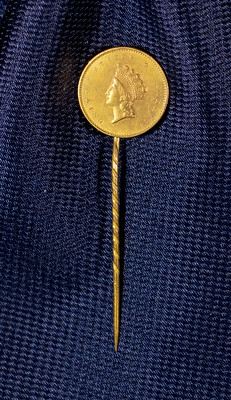 A gold stickpin crafted with a U.S. Type II $1 gold coin of 1854-1856, the Purser's keys to the treasure storage room and a sampling of nine unconserved pocket change coins gathered from the seafloor around the shipwreck of the SS Central America will also be offered along with nearly 300 lots of recovered exquisite Gold Rush jewelry, vintage 1850s clothing and other unique artifacts from the legendary ship.
A gold stickpin crafted with a U.S. Type II $1 gold coin of 1854-1856, the Purser's keys to the treasure storage room and a sampling of nine unconserved pocket change coins gathered from the seafloor around the shipwreck of the SS Central America will also be offered along with nearly 300 lots of recovered exquisite Gold Rush jewelry, vintage 1850s clothing and other unique artifacts from the legendary ship.
Clothing items include the important discovery of the oldest known Gold Rush-era miner's work pants jeans with a button fly that may have been made by or for Levi Strauss in his early years in business. The pants and early Brooks Brothers undershirts with the company's famous emblem that will also be in the auction were in the first-class passenger trunk of merchant and Mexican-American War military veteran John Dement of Oregon.
Seemingly ordinary items from the passengers and crew today give us
extraordinary insight into the everyday lives of the people who traveled on the steamship,
said scientist Bob Evans who was on each of the recovery missions.
The tragedy of the S.S. Central America sinking took the lives of 425 of the ship's 578 passengers and crewmembers, and the loss of the gold cargo was a major factor in the economically devastating financial Panic of 1857 in the United States.
Insurance claims for the loss were paid in the 1850s and the company that discovered and retrieved the treasure starting in 1988 settled with the insurers and their successors in 1992. With court approval, California Gold Marketing Group acquired clear title to all of that remaining treasure in 1999 as well as all the items recovered in 2014.
Holabird Western Americana Collections has prepared an extensive, limited
edition 280-page catalog with dozens of previously unpublished illustrations of the S.S. Central America recovery operations, some reproduced in 3-D as shot during the discovery missions with a remote-controlled submersible nicknamed Nemo.
Copies of the catalog are available while supplies last for $100 each with the price refundable with any purchase from the auction. Auction lots can also be viewed online.
For additional information about the recovered artifacts auctions planned for December 2022 and February 2023 and to obtain a printed catalog, visit Holabird Western Americana Collections of Reno, Nevada at www.HolabirdAmericana.com, call 775-851-1859, or email info@holabirdamericana.com.
NUMISMATIC NUGGETS: NOVEMBER 6, 2022
Here's a selection of interesting or unusual items I came across in the marketplace this week. Tell us what you think of some of these. -Editor
"1781" (1783) Libertas Americana Medal. Original. Paris Mint. By Augustin Dupre. Adams-Bentley 15, Betts-615. Bronze. MS-63 BN (NGC).
Great example of the classic of all classic U.S. medals. From the Stack's Bowers November 2022 Collectors Choice Online Auction. -Editor
To read the complete lot description, see:
"1781" (1783) Libertas Americana Medal. Original. Paris Mint. By Augustin Dupre. Adams-Bentley 15, Betts-615. Bronze. MS-63 BN (NGC).
(https://auctions.stacksbowers.com/
lots/view/3-ZXU68/1781-1783-libertas-americana-medal-original-paris-mint-by-
augustin-dupre-adams-bentley-15-betts-615-bronze-ms-63-bn-ngc)
The superb Naval General Service Medal awarded to Ordinary Seaman P. Cherry, Royal Navy, who was aboard the famous "Fighting Temeraire" at Trafalgar, whose ship played one of the most significant parts in that famous battle and later went on to find everlasting fame as the subject of one of artist J. M. W. Turner's most memorable and evocative paintings
Naval General Service 1793-1840, 1 clasp, Trafalgar (Peter Cherry.), good very fine
Great medal! From the Spink November 2022 Orders, Decorations and Medals sale. -Editor
To read the complete lot description, see:
THE SUPERB NAVAL GENERAL SERVICE MEDAL AWARDED TO ORDINARY SEAMAN P. CHERRY, ROYAL NAVY, WHO WA...
(https://live.spink.com/lots/view/4-7TFBY4/
the-superb-naval-general-service-medal-awarded-to-ordinary-seaman
-p-cherry-royal-navy-who-wa)
Victor D. Brenner (1871-1924, NY) bronze plaque of Abraham Lincoln in relief. Signed lower right, copyright 1907 by VD Brenner. Titled "Abraham Lincoln, 1809-1865". Victor David Brenner was one of the premier American metalists of the late 19th and early 20th c. He is best known for his design of the Lincoln penny. In fact, it was this 1907 relief plaque design which brought him to the attention of Theodore Roosevelt. He insisted that Brenner be the one to design the 1 cent coin to celebrate the Lincoln centenary. Mounted on a green marble back with bronze easel support. The plaque is 9 1/2" x 7", overall with mount 11" x 8 1/2".
A nice example of the classic Brenner Lincoln plaque mounted on green marble. -Editor
To read the complete lot description, see:
Lot 148: Victor D. Brenner (1871-1924, NY) bronze plaque
(https://www.invaluable.com/
auction-lot/Victor-D.-Brenner-1871-1924,-NY-bronze-plaque-148-c-89642969D5)
Vegvisir Wayfinder
The Vegvísir, or Norse compass, is an Icelandic magical stave, which, according to the Huld manuscript, protects one from losing their way in bad weather.
The Helm of Awe
Ægishjálmur, or Œgishjalmr` or in English, The Helm of Awe
, is a Nordic magical Stave which is meant to imbue its carrier with protection, and inspire victory in battle. We like to imagine helping in the day to day challenges of every day life, and how the stave might remind its carrier how strong they truly are at heart.
A few weeks back a reader asked if the Shire Post Mint in Arkansas was still in operation. I managed to lose the reader's message and address, so I'll answer here. Yes, they are still an active maker of fantasy pieces - this is from their latest email offering, received earlier this week. -Editor
For more on their Viking offerings, see:
https://www.shirepost.com/collections/viking
Earlier this year we sent out an email offering a large selection of Dan Carr pieces. Well, we're back with another big group that we acquired from a long-time customer of ours.
These are fantasy issues, all designed and produced by Mr. Carr. They are quite popular among many collectors (and a bit controversial among others). For those not familiar with him, he designed the actual New York and Rhode Island state quarters for the U.S. Mint.
All but one are ANACS certified. Some have the accompanying tag with his signature, most do not. You can find them in our Tokens category
Speaking of fantasies, Northeast Numismatics announced an offering of Dan Carr's controversial imaginings of U.S. Mint products such as the fabled 1964-D Morgan Dollar. -Editor
To read the complete item descriptions, see:
https://www.northeastcoin.com/inventory.jsp;
jsessionid=17C11F51EC771E5BFE031D8ECE6B0126
Thursday 15 December, 5pm to 8pm
Deck the halls! Get into the Christmas spirit by filling your own bauble using shredded banknotes. Sing along to a few carols with the Bank of England Choir and enjoy festive refreshments.
Baubles will be available while supplies last, limit one per person. Free, no need to book ahead.
At an upcoming evening event Bank of England Museum visitors can make a Christmas ornament with shredded currency. Cool - Build-A-Bear for money nerds. -Editor
To read the complete lot description, see:
Museum Late: The Christmas special
(https://www.bankofengland.co.uk/museum/whats-on/2022/museum-late-the-christmas-special)
THE AMAZING ATHENIAN TETRADRACHM
Michael Bugeja published an nice overview article on the Athenian tetradrachm on World Coin News. I appreciated the discussion of test cuts. Here's an excerpt - see the complete article online. -Editor
The Athenian owl is considered one of the greatest coins, not only because of its beauty, but because of its elegant design — head of Athena on the obverse, iconic owl image on the reverse, and identifying inscription — making it the prototype for centuries of coins worldwide.
There are several types of Athenian owls, with the first appearing circa 510 BCE. The owl graced Athenian coinage for centuries. The earlier designs, though highly collectible, are a far cry from the classical artistic standard beginning in 465 BCE and flourishing between 440-404 BCE.
The Athens tetradrachm [features] the obverse depiction of Athena, the Olympian goddess of wisdom and war.
Here is the Athenian owl reverse with olive spray (representing olive oil and peace — a gift from Athena) with a crescent moon and inscription ?T?,
an abbreviation of ?T?????? (The Athenians
).
As you can see, the above coin has a test cut to make sure it is not a fourrée or silver-plated base metal counterfeit from ancient times. Below is an example of an owl fourrée from the Heritage archives, which also has a test cut, revealing its counterfeit composition.
Test cuts appear on many ancient coins. Precious metals were especially desirable not only for coins but also for use in jewelry, ornamental, and religious objects. Silver from the great mines at Laurian, about 50 kilometers from Athens, played a central role in the rise of the city-state, underwriting a great navy and powerful military.
To read the complete article, see:
The amazing Athenian tetradrachm
(https://world.mintnewsblog.com/2022/11/the-amazing-athenian-tetradrachm/)
APHRODITE ZODIAC MEDALLION FOUND IN RUSSIA
An interesting early Zodiac medallion has been uncovered in Russia. -Editor
Russian archaeologists have unearthed an intricately detailed silver medallion of the Greek goddess Aphrodite in the 2,100-year-old grave of a young woman, possibly a priestess, on the northeastern coast of the Black Sea.
The medallion also shows 10 — not the known 12 — signs of the zodiac, and gives unique insight into religious practices at that time and place.
Some researchers have proposed that the woman in the grave was a priestess of Aphrodite, the ancient Greek goddess of beauty and love, but there's no way to be sure — although there are indications that her rings, silver earrings and other grave goods were also dedicated to the goddess.
"I do not call the woman buried with this medallion a 'priestess,'" Nikolay Sudarev(opens in new tab), an archaeologist with the Russian Academy of Sciences who helped make the discovery, told Live Science. But the burial and its goods appear to be "connected with the cult of Aphrodite," he said.
The silver medallion found in the early first century B.C. grave shows the embossed head, shoulders and hands of Aphrodite — identified by Sudarev and his colleague, archaeologist Mikhail Treister(opens in new tab), based on other contemporary iconographic portrayals.
The portrait is surrounded by 10 embossed symbols that correspond to signs of the zodiac, including a lion for Leo, a bull for Taurus and a scorpion for Scorpio. But the symbols for the zodiac signs Aquarius and Libra are missing, and the researchers don't know why.
According to Haaretz(opens in new tab), an Israeli newspaper, the inclusion of the zodiac indicates the medallion is a portrayal of "Aphrodite Urania" — the heavenly aspect of the goddess, as distinct from her Earthly aspect, "Aphrodite Pandemos."
It also suggests a belief in astrology, the idea that the positions of celestial bodies can influence events on Earth, which was widespread throughout the ancient world. "This is one of the earliest depictions of the signs of the Zodiac in the Greek world," Sudarev said. "This could have been brought from Ptolemaic Egypt."
To read the complete article, see:
2,100-year-old burial of Aphrodite 'priestess' discovered in Russia
(https://www.livescience.com/ancient-greek-phanagoria-aphrodite-cult-burial)
SWEDISH CACHE OF VIKING SILVER FOUND
Leon Saryan and Arthur Shippee passed along this article about a find of Viking silver in Sweden. Thanks. -Editor
A hoard of Viking silver, described as a once-in-a-lifetime discovery by onsite archeologists, has been unearthed in Täby, a municipality north of Stockholm.
As the Archaeologists, a team of specialists under contract from Sweden's National Historical Museums, dug beneath the decayed wooden floor of a building in a Viking Age settlement, they discovered a small ceramic pot. Inside lay eight neck rings, two arm rings, a finger ring, a pair of pearls, and 12 coin pendants deposited in a linen pouch.
The neck rings provoked particular excitement. Forged in the torque-style, a symbol of wealth and status for Viking men and women, the nearly 1,000-year-old rings were extraordinarily well-preserved despite having been made and deposited almost a thousand years ago,
said Maria Lingström, the archeologist who removed them from the ground. They looked almost completely new.
Silver hoards are significant in many ways. They reflect that their owners were very wealthy and are proof of advanced craftsmanship,
said Johan Anund the group's regional manager, but they also reflect ancient rituals and religion
said , the excavation also revealed more than a thousand other artifacts
The hoard of coins evidences the international nature of commerce in Viking Age Scandinavia, and includes silver from England, Bohemia, Bavaria, as well as dirhams, a type of Arabic coinage. The collection makes up what the Archaeologists termed a perfect example of [the era's] far-reaching connections and blossoming trade.
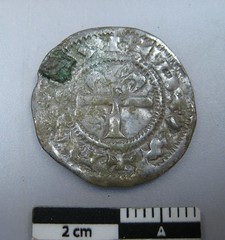 The cache also includes a 10th-century coin minted in Normandy, an area in northern France to which Vikings migrated in the early ninth-century, which had only ever previously been documented in an 18th-century book of drawings.
The cache also includes a 10th-century coin minted in Normandy, an area in northern France to which Vikings migrated in the early ninth-century, which had only ever previously been documented in an 18th-century book of drawings.
The artifacts have since been transferred to the Acta Konserveringscentrum, a conservatory company in Stockholm, to be cleaned and documented.
To read the complete article, see:
In a ‘Once-in-a-Lifetime' Discovery, Swedish Archaeologists Have Unearthed a Cache of Viking Silver That Still Looks Brand New
(https://news.artnet.com/art-world/in-a-once-in-a-lifetime-discovery-swedish-archaeologists-unearth-a-cache-of-viking-silver-2202955)
HOW MUCH IS THAT IN DOLLARS?
An American Numismatic Society Pocket Change blog article by David Yoon explores the age-old (and difficult!) question of how much a past coin was worth in terms of present-day money. Here's an excerpt - see the complete article online. -Editor
Something we are asked from time to time is how much a past coin was worth in terms of present-day money. It can be hard enough sometimes to say what the coin was worth at the time it was in circulation. Equating it to present-day money brings in some additional difficulties.
Let's consider one of the most important trade coins of the late Middle Ages, the Florentine gold florin. This was famously recognized as a stable standard of value in western Europe for centuries. Many works in economic history use the Florentine florin as a standard for comparing values between late medieval currencies.
There are various ways one could translate Florentine florins into United States dollars. The interesting thing is how different the results can be.
First, one could start with the material of the coin itself. In medieval European monetary theory, the value of the coin was derived from its precious-metal content, in this case, gold. At a current price of 1650 dollars per troy ounce, the 3.53 grams of gold in a full-weight Florentine florin would be worth about 187 dollars. So that's one way to give a dollar value to the medieval florin.
For comparing one year to another, economists use various measures to compare currency values such as the consumer price index (CPI), producer price index, and so on. These indices work by comparing prices of a variety of goods chosen to represent typical expenditures. Over time, the goods used in the index obviously change: personal computers cannot be used to measure consumer prices in 1922, whereas coal is probably not a significant part of calculation of consumer prices in the United States in 2022 (though they would certainly figure in a producer price index). However, very few goods can be compared between today and the Middle Ages, and evidence for medieval prices is limited.
Ordinary consumer expenses in medieval Florence were usually reckoned in lire, soldi, and denari di piccioli, and the value of the gold florin varied relative to this money of account. This billon denaro from 1336 illustrates the base unit of this system.
One commodity that does allow comparison is wheat, a basic foodstuff widely consumed both in medieval Europe and today. In Florence in the early 1330s, the price of wheat varied considerably depending on harvests (between 10 and 26 soldi per staio), but the 1331 cost of around 13 soldi per staio was not unusual. Assuming around 18 kilograms to the staio (a unit of volume), this equates to about 722 soldi per metric ton. By comparison, a metric ton of wheat currently costs about 340 dollars. A Florentine florin was worth around 60 soldi di piccioli in the early 1330s, so a metric ton of wheat would have cost around 12 gold florins at the time. In the wheat comparison, a Florentine gold florin in 1331 would be worth about 28.3 dollars.
Another comparison could be made using labor costs. The federal minimum wage in the United States is currently 7.25 dollars per hour, or 58 dollars for an 8-hour day. The median cost of an unskilled manual laborer in Florence was around 4.5 soldi per day. A gold florin could thus buy 13? person-days of unskilled labor so, in terms of labor costs, a Florentine florin would be worth around 773 dollars.
So three different points of comparison—wheat, gold, and unskilled labor—have given the gold florin values ranging from 28.3 to 187 to 773 dollars. All of these are reasonable points of comparison but clearly this range is so large that we have to question the meaningfulness of any one number. The relationships between agricultural productivity, household expenditure, and the overall economy are so different between 1331 and 2002 that any one point of comparison is misleading.
To read the complete article, see:
How Much Is That in Dollars?
(https://numismatics.org/pocketchange/florin/)
1930 AUSTRALIAN PENNIES COME TO MARKET
Don Cleveland passed along this impromptu Australian treasure hunt story with a happy ending for six participants. Thanks! Great story. -Editor
Six lucky Australians have found rare 1930s pennies potentially worth a small fortune after searching through their drawers.
It comes after one rare penny sold for a record-breaking $60,000 at auction last month.
Since then, a handful of Australians have searched their homes for their own rare pennies.
Following the news of the penny breaking a record at Lloyds Auctions, people were flooding our phones in hopes they had one of these rare pennies and from this we have now seen six more come to auction,
Lloyds Auctions chief operations officer Lee Hames said.
We had customers going through their drawers following the news of the last penny sale and to the surprise of some custodians they found their own 1930s penny which we now have up for auction.
Hames said the six 1930s pennies up for auction this Sunday are expected to collectively achieve well into a six-figure sum.
Two of the pennies have a grading of very fine, that being better than the penny we sold last month, so we could possibly see these two pennies break another record,
he said.
The six 1930s pennies will go under the hammer from 7pm this Sunday, November 6 through Lloyds Auctions.
Hames said the record-breaking penny was a product of the Great Depression in 1929, when Australia's shrinking economy caused lower demand for currency. While about 3000 pennies were accidentally
minted in 1930, only about 1,500 ended up in circulation.
Many were damaged and discarded over the years and it is unknown exactly how many are in collectors' hands today.
To read the complete article, see:
Six rare 1930s Australian pennies up for sale
(https://7news.com.au/business/finance/six-rare-1930s-australian-pennies-up-for-sale--c-8735524)
COMMEMORATIVE MEDAL ON THE BLACK DEATH
Jeremy Bostwick published a short article this week on the Stack's Bowers blog about a medal related to the Black Death. Creepy cool! -Editor
As very recent history should show, any emergence from the specter of mass disease is always most welcome and worthy of commemoration. This sense of optimism and yearning for life as it was before
is recounted through numerous works of medallic art from the early modern period. One such instance is a rather rare and interesting silver medal in our upcoming November Collectors Choice Online (CCO) auction. Issued in 1683 for the city of Erfurt in Germany, this specimen—likely holed for wearing as a charm—features a scene that would be quite appropriate for this past week's Halloween festivities, with the Archangel Michael standing facing in full armor. With a radiant nimbus crown encircling his head, he places his sword back in its scabbard, as he had finally slain the wickedness of the disease that had so ravaged the city.
From the summer of 1682 and stretching into 1683, the black death—a common pestilence to strike the urban locales of Europe—would consume nearly half of Erfurt's population, over some 10,000 citizens. Understandably, the iconographic representation of the disease on this medal is that of a skeleton—as it represented human frailty; it is upon this heap of bones that Michael triumphantly stands. To further drive home the poignancy and the idea that the medal was a memento mori, a skull and crossbones rests atop a draped altar in the background to left. On the reverse is a city view of Erfurt along with a radiant personification of the sun—symbolizing the new dawn rising within a city that had lost so much.
To read the complete article, see:
A MEDALLIC COMMEMORATIVE PERTAINING TO THE BLACK DEATH
(https://stacksbowers.com/a-medallic-commemorative-pertaining-to-the-black-death/)
CANADIAN WAR MUSEUM ADDS VICTORIA CROSS
The Canadian War Museum has acquired a Victoria Cross. -Editor
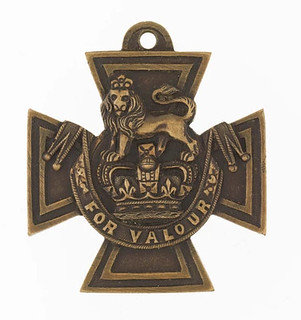 Tommy Holmes' Victoria Cross is now in the Canadian War Museum's care.
Tommy Holmes' Victoria Cross is now in the Canadian War Museum's care.
Holmes is one of three Victoria Cross winners celebrated in Owen Sound, along with Billy Bishop and David Currie. At 19 years, Holmes was one of the youngest Canadians to be awarded the Commonwealth's highest military honour for bravery.
The War Museum already displays the VCs of Bishop, the First World War flying ace, and Currie, the Second World War tank battle group commander. There are no immediate plans to display Holmes' medal, confirmed Eric Fernberg, a collections specialist at the War Museum.
But having the Holmes VC is important for posterity as well, he said.
Each story is of exceptional bravery, extraordinary circumstances . . . They represent the very best of the brave,
he said. For many people, the VC symbolizes that ultimate commitment and sacrifice to military service.
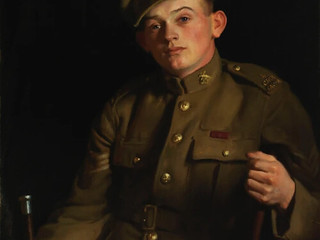 The Billy Bishop Museum in Owen Sound displays replica Victoria Cross medals of its three war heroes.
The Billy Bishop Museum in Owen Sound displays replica Victoria Cross medals of its three war heroes.
It's really exciting that the Canadian War Museum has found a real Victoria Cross that was Tommy Holmes',
said Emily Jolliffe, the Billy Bishop Museum's director and chief curator.
Holmes grew up in Owen Sound and is buried in Greenwood Cemetery, as are Bishop and Currie.
To read the complete article, see:
Canadian War Museum has purchased Tommy Holmes' Victoria Cross
(https://www.owensoundsuntimes.com/news/local-news/canadian-war-museum-has-purchased-tommy-holmes-victoria-cross)
LOOSE CHANGE: NOVEMBER 6, 2022
Here are some additional items in the media this week that may be of interest. -Editor
Get It.
Steve Roach and Dennis Tucker write a column for the Official ANA Blog. Here's an excerpt from the October 2022 installment - see the complete article online. -Editor
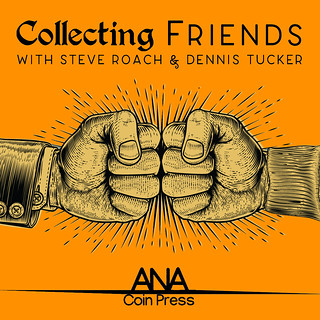 One of the great things about our hobby community is the friendship that develops over time. When you're with other collectors, you speak the same language, you know the same stories, you have the same background—even if you were born miles apart, generations apart, or in different cultures.
One of the great things about our hobby community is the friendship that develops over time. When you're with other collectors, you speak the same language, you know the same stories, you have the same background—even if you were born miles apart, generations apart, or in different cultures.
When you go to a coin show, or attend a club meeting for the first time, it's easy to make new friends. Just ask the question, What do you collect?
Boom! An instant ice-breaker that immediately launches an interesting conversation, and an easy way to get to know somebody!
If your new friend has been collecting longer than you, you have an opportunity to absorb knowledge. If you've been collecting longer, it's a chance to share and teach. But you'll both be learning.
On the other side of the coin are non-collector friends and family who just don't get it.
Hard as it is to imagine, some people are immune to the bite of the collecting bug. I remember when I was about fourteen and a friend's father, who learned about my hobby, asked with a laugh, What do you do after school, go home and polish your coin collection?
The nerve! Never mind that you should never clean a coin with polish. Of course I didn't clean them—I constructed little boxes filled with cotton to store and study them, like any reasonable coin-collecting kid would!
To read the complete article, see:
COLLECTING FRIENDS: WHEN FRIENDS AND FAMILY ATTACK!
(https://blog.money.org/coin-collecting/friends-and-family)
An export block has been issued on a Victoria Cross medal in hopes a UK buyer will emerge. -Editor
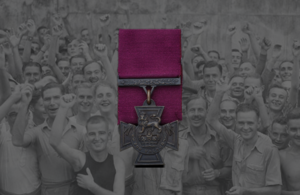 A Victoria Cross awarded to RAF Squadron Leader A.S.K. Scarf is at risk of leaving the UK after being sold abroad for more than £660,000.
A Victoria Cross awarded to RAF Squadron Leader A.S.K. Scarf is at risk of leaving the UK after being sold abroad for more than £660,000.
The medal, along with four others - the 1939-1945 Star, Pacific Star, Defence Medal and British War Medal - was awarded posthumously to Scarf in 1946. The Victoria Cross was presented to his widow, Mrs Elizabeth Scarf, by King George VI at Buckingham Palace.
While the campaign medals within this group are relatively common and were issued to all personnel who met the qualifying criteria, the Victoria Cross is incredibly rare. Only 1,358 have been awarded since its inception in 1856 with just 181 awarded during the Second World War. Of the 22 awarded during the conflict to the RAF, this Victoria Cross is of particular interest because it is the only one awarded to the RAF for their service in the Far East.
To read the complete article, see:
Rare Victoria Cross awarded following Far East battles in Second World War at risk of leaving the UK
(https://www.gov.uk/government/news/rare-victoria-cross-awarded-following-far-east-battles-in-second-world-war-at-risk-of-leaving-the-uk)
In the I've-always-been-too-afraid-to-try-that department is this video examining the effect of a coin dropped from the top of the Empire State Building. Check it out... if you dare! -Editor
 On Veritasium, they wanted to check out the oft-repeated myth that you could be killed, or at least badly injured, by a penny dropped from the top of the Empire State Building.
On Veritasium, they wanted to check out the oft-repeated myth that you could be killed, or at least badly injured, by a penny dropped from the top of the Empire State Building.
To test the idea, they recruited none other than MythBuster OG, Adam Savage.
To read the complete article, see:
Can a penny dropped from the Empire State Building really kill you?
(https://boingboing.net/2022/11/02/can-a-penny-dropped-from-the-empire-state-building-really-kill-you.html)

